-
Posts
808 -
Joined
-
Last visited
Content Type
Profiles
Forums
Gallery
Events
Posts posted by Rik Thistle
-
-
Thanks Andy.
I am assuming that on the way to Verrieres (before the fighting started) the Archer did pass some farms. The 17Lb gun may have been accurate up to about 1 mile range (?), so perhaps was used to slow down German tanks headed towards reinforcing the ridge?
The Verrieres Ridge itself does, as you note, look out over some open countryside, from what I see on that video.
I can find Operation Spring maps on the web eg .... https://valourcanada.ca/military-history-library/operation-spring-1944/
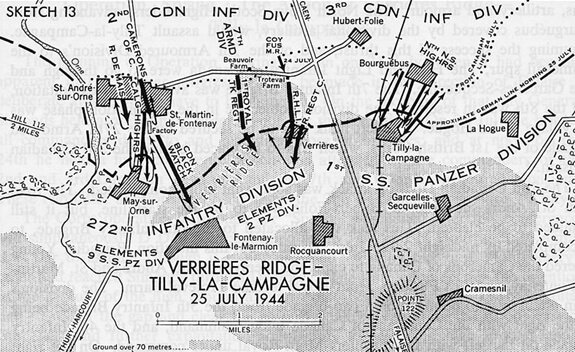
If I need more I'll drop you a PM.
Thanks again,
Richard
-
Hi all,
Another update on progress on the Archer, and where I've sited it.
Firstly, adding the final parts to the Archer.
The gun mantle was slightly difficult for me to locate on the fighting compartment...there are a couple of alignment slots on the compartment/breech and I eventually got the mantle settled in the correct position.
The two tow cables wind their way round the front of the vehicle, held in position by some very tiny hooks. A couple of them did fly out of the tweezers but were found.
Below, the tow cables in position. Judging the cut length had to be done carefully.
Below, the Archer pretty much assembled. The Canadian marking transfers still to be added plus some more weathering.
A quick look at the crew, awaiting assembly
I've decided to locate the Archer on the way to the Verrieres Ridge, as mentioned by Andy (realworkingsailor) in post #5. I wandered through Google Maps to find a suitable location that matched how I already envisioned the scenario.
Whilst doing that, this came to my attention. During WWII the Germans made an art out of 'hedgerow warfare'. A great read on that subject is here 'Combat in Normandy’s Hedgerows' -https://warfarehistorynetwork.com/article/combat-in-normandys-hedgerows/ A couple of extracts follow..
"Pushing inland, the 26th primarily encountered open fields, and from June 7 to 12 they marched 20 miles, plowed through moderate resistance, and bagged POWs. But deeper inland enemy-occupied hedgerows abounded, freezing the American momentum on June 13 at Caumont le Repas. Locked in a 30-day stalemate, the GIs soon discovered that the terrain fostered a glaring paradox. They could not see the Germans, but the Germans could see them. The hedgerows reduced visibility and precluded mobility, forcing both sides to exchange mortar fire and conduct reconnaissance patrols.
--------
Cattle, living and dead, were abundant across Normandy and delivered vital information in their own right. A dead cow cautioned that a field or trail might contain mines and acted as a landmark, giving GIs a sense of direction in the confusing twists and turns. Grazing cows were often a sign that an area was free of mines. American and German soldiers monitored the behavior of cattle. Those that stared at a hedge might be indicating that an enemy soldier was hiding in or near it."
It would seem that French farmers divided land in to fields by using very thick hedgerows planted on raised banks. The Brits were probably a bit more used to hedgerows (and dry stone dykes) but even then the French ones would still be quite a challenge to navigate.
Below, a picture of a typical modern French hedgerow in the Verrieres region. I'm not sure if back in WWII days the farmers had got round to using fence posts and wire to keep animals confined. More later. Also ditches seems to be a very common feature at the edges of these French fields.
The pic below is close to the scenario I had imagined, and is in the Verrieres locality. The black box outlines the Archer position. The metal gate is modern - a wooden one will replace it. The raised hedges are still apparent but now, I suspect, reinforced by wire fencing. The road would not be Tarmacadam back in the day....it would likely still be dirt.
A sketch of my scenario. I'm now thinking about whether or not I need to replace the fencing with banks and hedges.
Preparing the scenario base.
A quick check to see if the Archer fits and the layout makes sense. Not sure about the gun sticking out though :-# ?
A quick layout check with some of the main players.
Lots more still to do. But I was glad to have found 'Combat in Normandy’s Hedgerows' - https://warfarehistorynetwork.com/article/combat-in-normandys-hedgerows/ ... it has opened my eyes and added new dimensions to the scenario.
All for now ,
Richard
Edit: Fencing wire was invented long before WWII, and with barbed wire being used in WWI and WWII prisons. Whether it was yet cost effective for French farm widespread usage around WWII time I'm not 100% sure, especially since they already had quite effective hedges (for containing livestock). However there are images on the web showing some fenced French fields during WWII eg https://www.theatlantic.com/photo/2011/07/world-war-ii-axis-invasions-and-the-fall-of-france/100098/
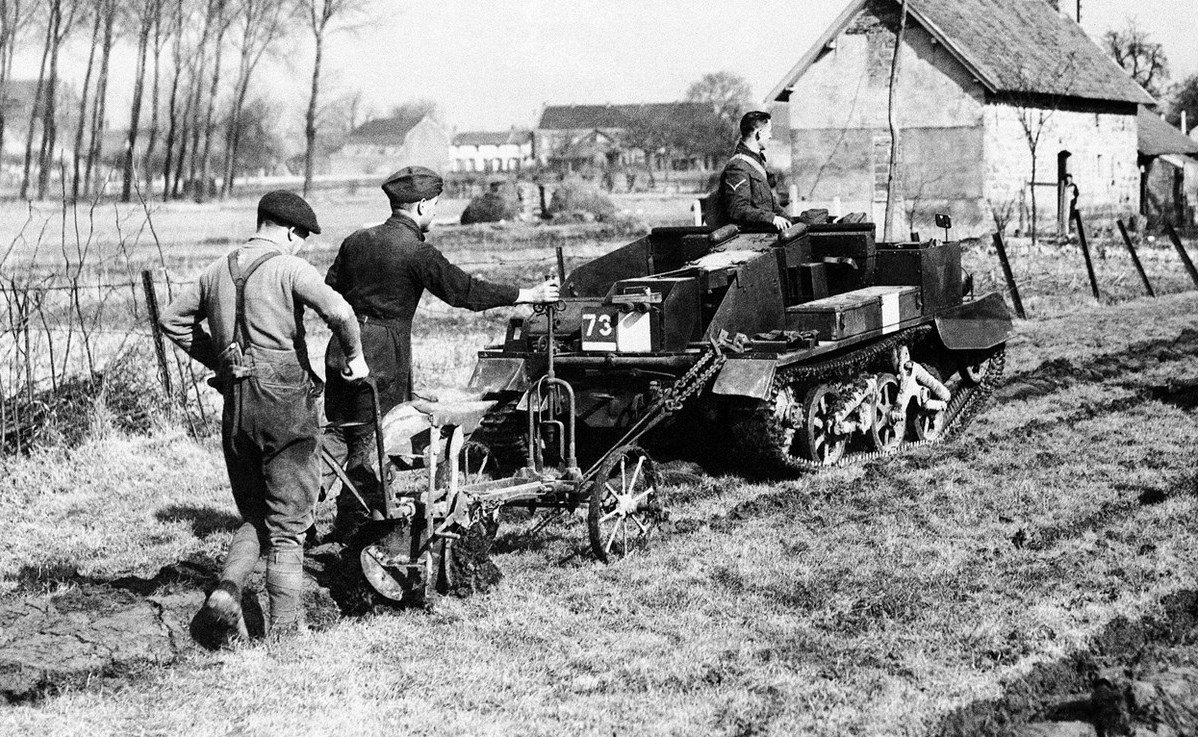
10. The Royal Irish Fusiliers of the British expeditionary forces come to the aid of French farmers whose horses have been commandeered by the French Army. A tank is hitched to a plow to help with the spring tilling of the soil on March 27, 1940. #
-
-
OC,
Great build!
I've seen the Harriers do their stuff at many airshows...nothing beats seeing a fighter jet flying backwards!
I imagine you have read it, but just in case, 'Sea Harrier Over The Falklands' - https://www.amazon.co.uk/Sea-Harrier-Over-Falklands-PAPERBACKS/dp/0304355429 is a no-punches-pulled account of what 'possibly' happened in the Falklands.
"Sharkey Ward commanded 801 Naval Air Squadron, HMS Invincible, was senior Sea Harrier adviser to the Command, flew over sixty missions and was awarded DSC. Yet had he followed all his instructions to the letter, Britain might well have lost the Falklands War."
Richard
- Jack12477, king derelict, mtaylor and 3 others
-
 6
6
-
Thanks Alan,
Since posting I've decided the Archer position is inside another field accessed via a field gate. The Archer is approximately 9 feet wide, so should fit within a typical French field gate (TBC).
This is a developing story, so don't touch that dial 😉
Richard
- Egilman, mtaylor, realworkingsailor and 4 others
-
 7
7
-
Thanks OC.
The scenario is still at the 'not sure where it is really going' stage but I feel I may be homing in on something suitable. I like showing how everyday life tried to coexist with the surrounding strife.
Still lots to do though 🙂
Richard
- mtaylor, Old Collingwood, Canute and 1 other
-
 4
4
-
Hi all,
Another short post, that actually covers a fair bit of work but since most of it is adding small details etc there weren't many pictures taken.
Firstly filling in some gaps etc with AK Grey Putty.
Then on to the exhaust system. I've tried giving it a bit of weathering/rust and it looks OK, from a distance.
Clamping together two halves of the exhaust.
I've bought some Tamiya 1:35 scale livestock. It is actually quite lifelike although the join round the neck needed a bit of filling.
I had wondered how French farms had kept functioning during the war - it must have been quite challenging. It seems horses were nabbed to be used as beasts of burden by the military forces. But cattle etc were probably left alone?
Below - a possible scenario. The Archer has just pulled up to the side of the road in support of the quickly advancing Infantry.
Marguerite suspects this is the daily hay delivery, Muffin is wandering over to have an investigation also ... as soon as the first shell departs neither will be seen for dust.
Meanwhile a foot patrol passes by along the country road. The fuel drum is empty. I'll make up some decent looking trees, and I'm trying to figure out a way to use another French road sign :-)
I'm aware the Archer is Canadian and the troops are British. But I guess each supported the other as required?
Thanks for the Likes and suggestions in the previous post - much appreciated as always.
Richard
- GrandpaPhil, mtaylor, Jack12477 and 7 others
-
 10
10
-
TALLY HO on YouTube
Yes, excellent bunch. And they cover the age spectrum, seem very happy at what they do and have a very good project manager (and owner) in Leo.
It's one heck of a project.
Richard
- mtaylor, Keith Black and FriedClams
-
 3
3
-
Andy,
Yes, I've watched it...some useful info in there.
I was going to say 'neat reversing'...over the logs on to the pontoon boat (4.57 mins)....but of course he is in a Forward gear.
I wonder where all the logs came from... they pop up in a lot of different settings...was there a dedicated 'tree felling & supply division'? Hmm... I guess it would be the Royal Engineers.
Richard
-
James,
I had a read of your link, and then found that the Spitfire sadly failed to sell.... Fully restored Spitfire that shot down Focke-Wulf 190 fails to sell at auction - https://www.forces.net/technology/aircraft/fully-restored-spitfire-shot-down-focke-wulf-190-fails-sell-auction But some interesting info contained in the link.
Richard
- Old Collingwood, Egilman, Jack12477 and 3 others
-
 6
6
-
Egilman,
Thank you for all that - great info.
I agree that a Bailey Bridge would make a good setting but the size would not work with my 10" deep shelves.
As part of my re-education of WWII events (last time was at school, a long time ago) I had read that the USA had been quite pernickety about standards, especially interoperability between similar USA made equipments, but that would have held for only within the USA itself. Seems a bit of an advantage was lost with the UK and USA building Bailey Bridges to different tolerances.
Anyway, as you mention, I have moved away from the idea of using a Bailey Bridge. I've probably got a shelf footprint of about 10" x 12" to play with...much the same as the Churchill tank.
When I bought the Tamiya Archer kit I did so because it looked quite detailed and unusual. It also had an interesting development history, and was used by the Brits, Canadians and Poles. But I hadn't yet finished my Churchill scenario so didn't quite appreciate the enjoyment that designing and building 'scenarios' gives.
With 20:20 hindsight I might have chosen a different kit. But now that I am part way through the Archer kit I don't really regret that decision....the Archer could just be positioned on the shelf without a scenario, and then look for another kit but this time with the end-scenario in mind.
Regards,
Richard
- Egilman, popeye the sailor, mtaylor and 4 others
-
 7
7
-
Andy,
That's a good picture and I have seen it. It tells a reasonably peaceful story.
The slight issue with the Tamya Archer is that the three man crew are in the middle of firing off shells. I have toyed with maybe re-modelling them in to more passive positions but that could be a hassle.
So I need to come up with a scenario where the Archer is engaging the enemy, but with some kind of side story(s) and in an interesting setting.
I do have some 'brick wall' left over from the Churchill build, and Tamiya's Oil Drum and Jerry Can kit. ( https://www.amazon.co.uk/Tamiya-35026-Jerry-Cans-Scale/dp/B000WNCDLO ) And a decent amount of hedge material, grass etc. Also, I have a thought about getting some model critters that one would see in the countryside.
Anyway, plenty time to get my head round this, but any further thoughts....then keep 'em coming.
Thanks,
Richard
-
Hi all,
Some more build pictures etc on the Archer self propelled gun.
There are a lot of parts to it, much more than the Tamaya Churchill tank, so I'm only posting pics of significant stages.
Below, shows how the Upper Hull is fitted, plus some of the hull parts.
The paint is mostly drab olive, applied with brushes. I've started adding a bit of weathering but lots more to come.
Below, some of the internal fittings installed eg moveable gun mount, seats etc. I'm not sure if the seats would have had padded brown leather upholstery, or just be plain sheet steel. But to add a bit of colour contrast I've given the crew the the benefit of brown upholstery, and added some shiny (worn) metal highlights.
Another pic of the above, from a different angle. The change of colour is due to me using the Flash on my phone, or not.
A good look inside an actual Archer is available here.... 'Inside the Chieftain's Hatch: 17PR SPM Archer, Pt 2'
Above - As you can see, everything has been painted drab olive green. This may have been part of a 'refresh' for the museum, but I suspect the paint job isn't that different from what was used in WWII.
Talking of paint, I have moved away from the AK Interactive 'wet palette' to a small mixing dish. The palette was prone to the colours running in to each other if moved....otherwise, it's still a useful tool.
Now preparing the Fighting Compartment sides for fitting to the hull. The shells should be a shiny brass colour, but the closest I had was a dark yellow.
Instructions on how to attach the sides.
And now it is beginning to look a bit more like a self-propelled gun.
And a final pic from above.
I still haven't figured out a compact scenario for this Canadian Archer.... but there are a couple of wartime pictures here that might give me some inspiration.... https://tank-afv.com/ww2/gb/Archer_17pdr_SPG.php ie ...in amongst a few comrades and some supplies - 'The Archer conducting fire support. Goch, Febuary 1945.' and in a treeline - 'An Archer near Nutterden, 9 February 1945'.
Any other suggestions gladly received.
Well, that's it for this week, back soon,
Richard
-
Firstly, and as usual, thank you for the feedback and likes.
Now a brief update on the Archer hull, wheels and tracks.
Below - The build starts off quietly with fitting a seat and some end plates.
I had painted all the sprues primer matt black, knowing I'd probably have to scrape the paint away from mating glued surfaces. I think it's a 50:50 decision whether to wait till the sub-assemblies are ready before priming, or priming the bare sprues. I did wash the bare sprues in warm soapy water first.
Some more interior panels and bulkheads being fitted, plus the shell racks.
Now getting on to the slightly more tricky (for me) stuff...the suspension and wheels. Apart from the sprocket wheel at one end and a metal wheel at the other end, the middle wheels all have black rubber 'tyres'...in the kit there are no separate tyres....I just need to paint the wheel perimeters black to simulate tyres.
Another pic of the suspension and wheels.
Now the that the undercarriage is done, next is the tracks.
The tracks are a bit fiddly - made of numerous single links, small groups of links and two long lengths of links. A middle guide runner, one each side of the hull, has a single locating pin on it.....a specific locating hole on the top long length of track fits onto the that pin.
Below - the instructions showing how the single links wrap around the end wheels.
Finally, the tracks are completed. I gave them a base coat of silver paint, then filled in the gaps with some mahogany brown paint and then later went back over the outer part of the tracks with gunmetal grey paint. Also, earlier, I had started laying some dark green paint onto the hull surfaces. I'm only using Acrylic paint.
I haven't recently thought too much about the final scenario/diorama, although incorporating a Bailey Bridge in to the layout was investigated.
However, the bridge will be quite long so that will make the footprint of the layout a bit on the big side. On the other hand, Bailey Bridges did have walkways to their side for infantry to use...so it might be possible that the British Army figures I have could be passing in one direction whilst the Archer moves in the other. Thing is, the Archer crew are in the act of firing and I doubt they would draw enemy fire on to a vital piece of equipment such as a Bailey Bridge. Still thinking.
All for now,
Richard
-
Andy,
the most plausible would be Operation Totalize, Aug 7 - 10 1944.
I'll have a read up on period. And what happened thereafter whilst I assemble the Archer.
It might be that my scenario/diorama is just the Canadian and British soldiers having a brew-up near the end of the war. Mind you, the Tamiya supplied figures look like they are in the middle of sending out some shells...so the brew-up would have to wait.
Richard.
-
Chris,
I confess I had to Google Wespes and StuGs! but now I get it...17 Lbs of visitor incoming.
Andy,
2nd and 3rd....yes, a typo is most likely. Just had a re-read of your Churchill links - very useful. But the downloadable .pdfs do take a while - however , I'm not going anywhere so time is not an issue.
I kinda guessed the British Army uniform colours may have been different from the Canadian ones. But I'll figure out a way how their paths crossed in the Archer scenario 😉
Richard
- ccoyle, Old Collingwood, Canute and 3 others
-
 6
6
-
Hi all,
Here is the introduction to my build of the Tamiya 1:35 scale Archer vehicle.
First some box artwork.
The version I will build is centred on the 2nd Anti-Tank Regiment, 3rd Canadian Infantry Division, which used the Archer in North-West Europe early 1945. There is also available in the kit, markings for a 7th Anti-Tank Regiment Polish II Corps, active in Italy early 1945. I expect I will build a scenario/diorama around the Archer.
The contents of the box.
The Canadian markings.
Strangely enough, the Tamiya blurb inside the box says the Archer was used by the 1st Canadian Infantry Division's 3rd Anti-tank Regiment....rather than the 3rd Canadian Infantry Division's 2nd Anti-Tank Regiment? Any thoughts anyone?
Over the past couple of weeks I have also built 5 British Infantry figures...I'll try to use them in any scenario I come up with plus, perhaps, some German road signs (probably made by MiniArt).
So I'm now off to do a bit of reading up/research on what part of the Canadian forces using the Archer were active in North West Europe 1945, and where and what they were doing. Andy (realworkingsailor) on MSW had already provided some references during my Churchill tank build.
Back soon'ish,
Richard
- Roger Pellett, mtaylor, Baker and 12 others
-
 15
15
-
Egilman, Ken,
Thanks again for your, as usual, very useful inputs.
I did have a quick scan of some of the US CoS reading lists... there is so much in there....where to even start?
Ken, I can't begin to imagine what it was like to participate in the Vietnam war, just like any war. I have worked with people who have seen active duty but they tend to keep their stories to themselves. That's not to say I didn't learn anything of what they got up to, but that was usually after a bit of throat lubrication....and mostly related to the after-hours activities...stories for another venue perhaps 😉
On a general note, I didn't think for one minute when I bought the Churchill tank kit it would lead to learning what I have about what went on in WWII, and elsewhere. On one hand it is extremely interesting, on the other it is sobering.
Richard
- Jack12477, Old Collingwood, mtaylor and 2 others
-
 5
5
-
Egilman,
No one took the battle worse or had a harder time than the Germans,
Yes, the suffering and sacrifice was tremendous on both sides.
I recently read 'A Higher Call: The Incredible True Story of Heroism and Chivalry during the Second World War' - https://www.amazon.co.uk/gp/product/B00BOA9MVI/ref=ppx_yo_dt_b_d_asin_title_351_o02?ie=UTF8&psc=1
I had seen the book recommended on MSW. It is a tremendous read, covering the perspectives from inside the American and German airforce camps....really quite eye opening.
Richard
-
Yeah, the Canadians had a very rough go in Normandy. While the Americans and British garner the lion’s share of attention from most historians, the Canadians have been largely forgotten.
Our Polish allies also did more than their fair share of fighting. I don't think anyone put on a short shift but, as you note, whoever tends to write the history books tends to influence where the attention goes.
Richard
-
Hi Andy,
Thanks again for all the very helpful inputs.
Yes, assimilating all the disparate information sources I used for the Churchill tank (3rd Tank Battalion, Scots Guards) into a clear (to me) context was quite a challenge. I don't have an active military background so it was kinda like learning a new language whilst being in country. I think I spent as much time reading as I did building, which is probably par for the course for dioramas / scenarios.
One site I did find (comparatively) easy to follow on the Scots Guards movements in Normandy was WW2Talk .... https://ww2talk.com/index.php?threads/account-3rd-tank-bn-scots-guards-jul-1944-may-1945.31187/ It is basically a daily diary of events plus hand drawn maps and names of the main players. I haven't had a look yet but I'm hoping it will have similar for the Canadian Forces.
I'll also investigate the Mark Zuehlke books you mention.
I did enjoy the Churchill tank build, with most of the enjoyment probably coming from trying to figure out a reasonably realistic scenario and one that would fit on a 10" deep shelf. With 20:20 hindsight I would probably now have rotated the scenario 90 deg so that the 3rd pic above is the main viewpoint when on the shelf - unfortunately it is currently too 'long' to sit comfortably on the shelf, so it sits side-on ie you see the Farmer's back (Pic 2).
Richard
Edit: Yes, it looks like the Zuehkle books are available in Kindle format on Amazon UK .... I had a quick listen to the 'Breakout from Juno' Audio snippet .... it sounds detailed and not at all 'dry'....however, the carnage sounds brutal.
-
Andy,
Good stuff and thanks.
I'll study all that as I start my preps for the Archer...there is a lot to learn and understand.
Richard
- Jack12477, mtaylor, Old Collingwood and 3 others
-
 6
6
-
Phil, Jack Patrick,
Thanks for that.
I deliberately finished the build off kinda quickly since I was getting in to a closed loop as I keep thinking of extra features to add...so did a quick wrap up.
I'm now assembling 5x Tamiya British WWII Infantry chaps, to improve on my figure painting.
Then on to the Tamiya Archer self propelled gun. That will take a good bit of reading up on the Canadian Divison that used them in Normanday - that will be interesting.
Richard
- Canute, Ryland Craze, Egilman and 5 others
-
 8
8
-
Thanks Ken,
Yes, from what I have recently read, an awful lot of the signposts were deliberately dug up, damaged etc...no point in making life easy for an opponent.
I was quite surprised how large and substantial the French concrete signposts could be. But there is no point in having small, weak signposts, I guess.
Richard

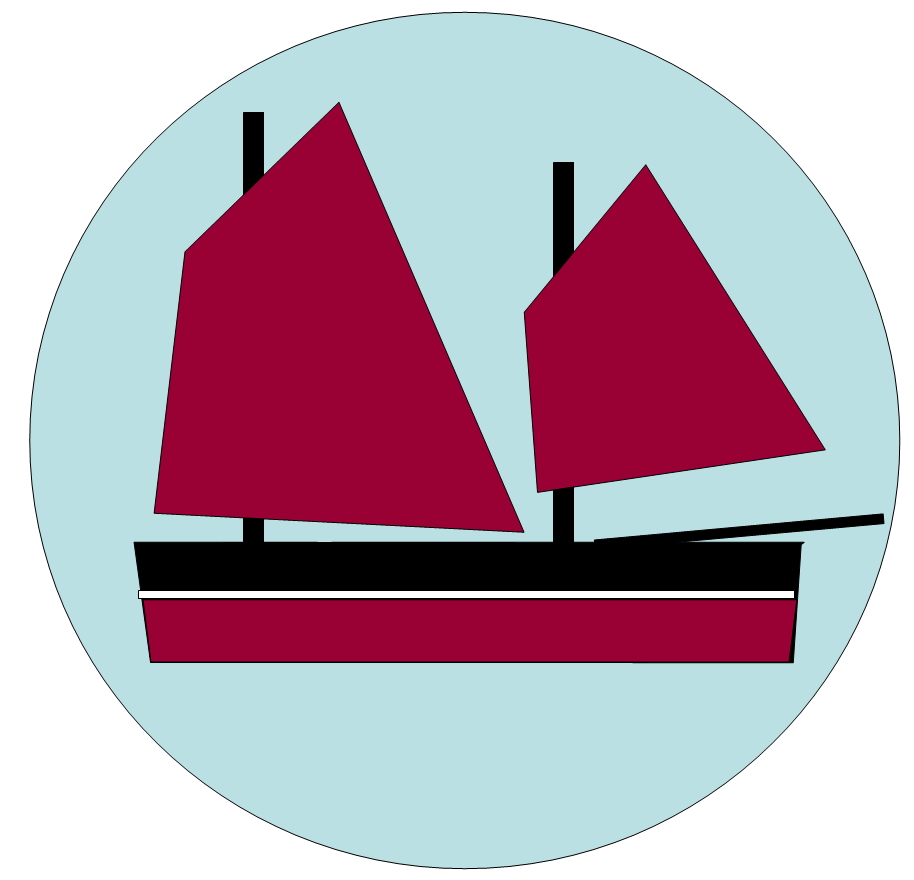
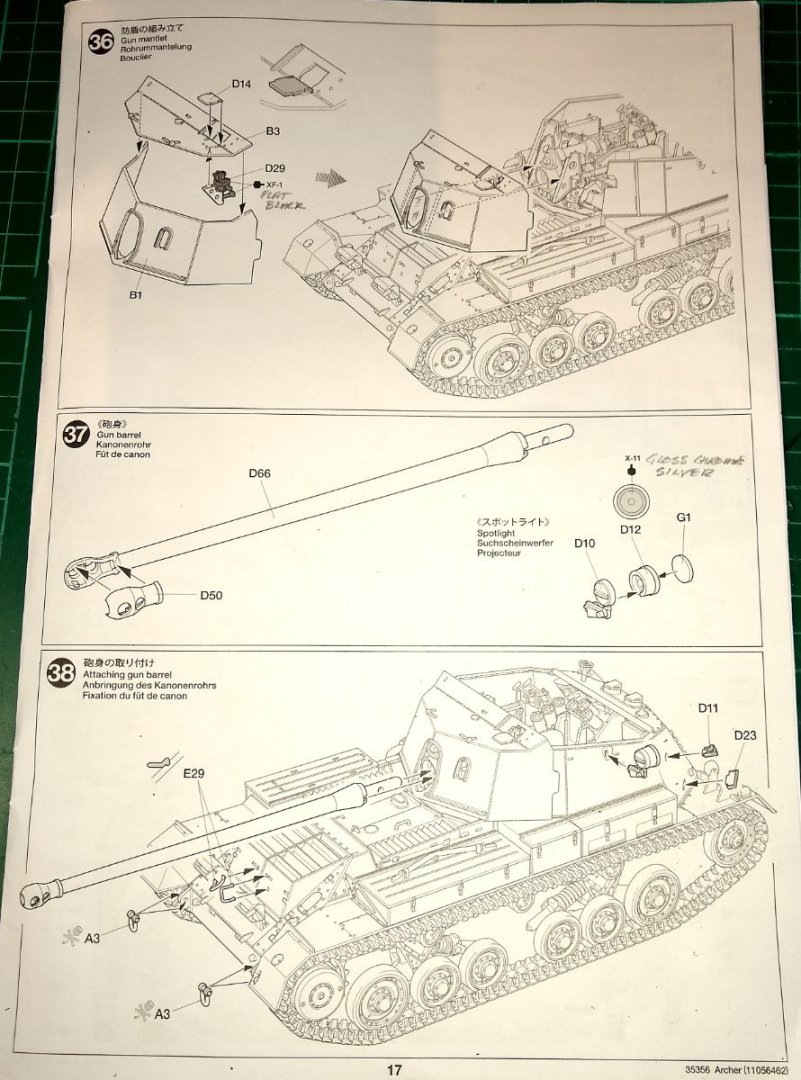

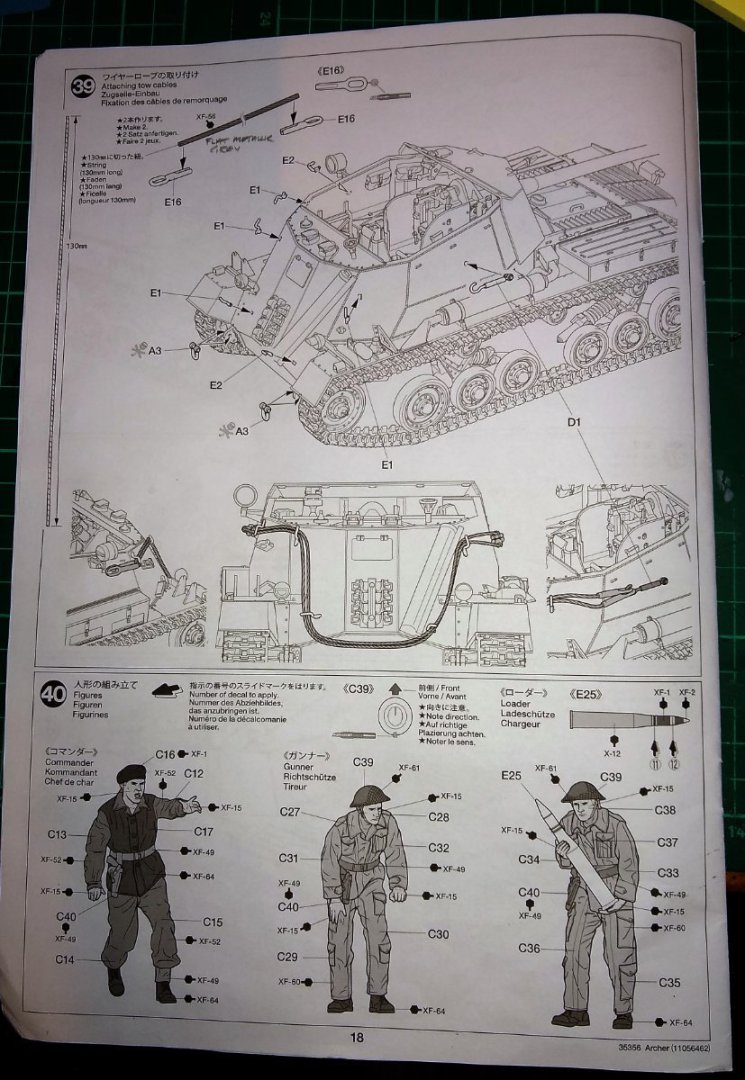
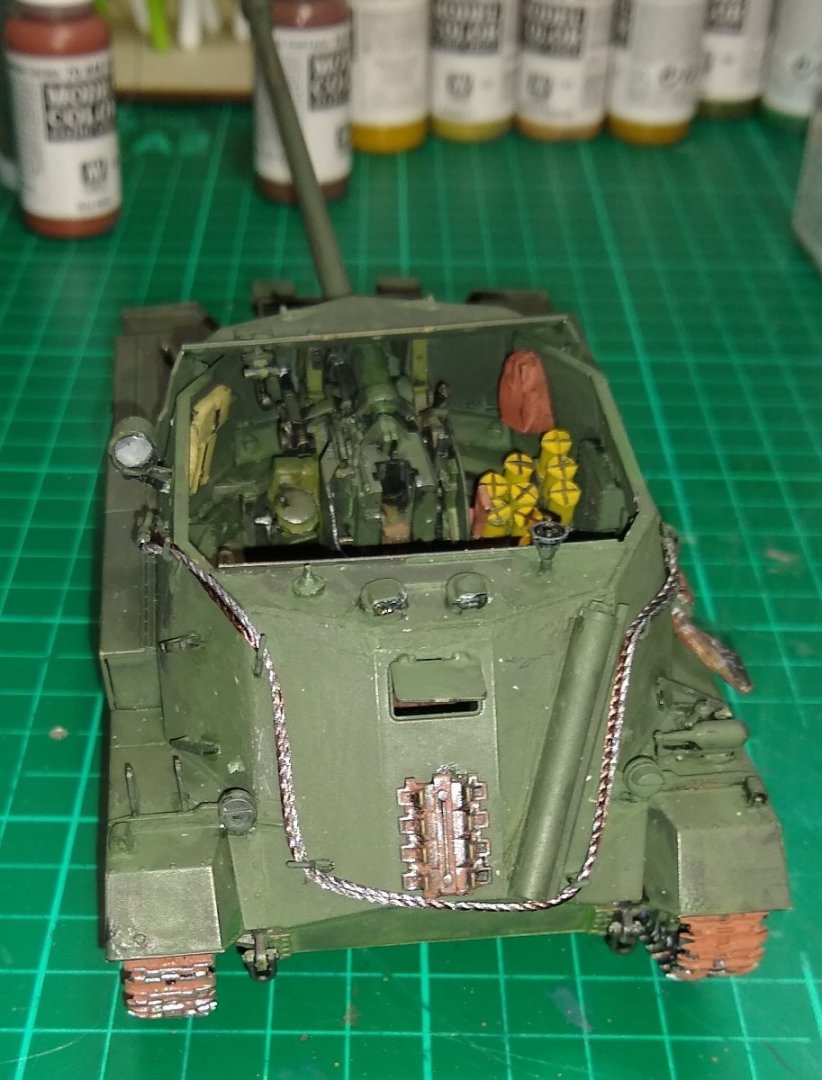
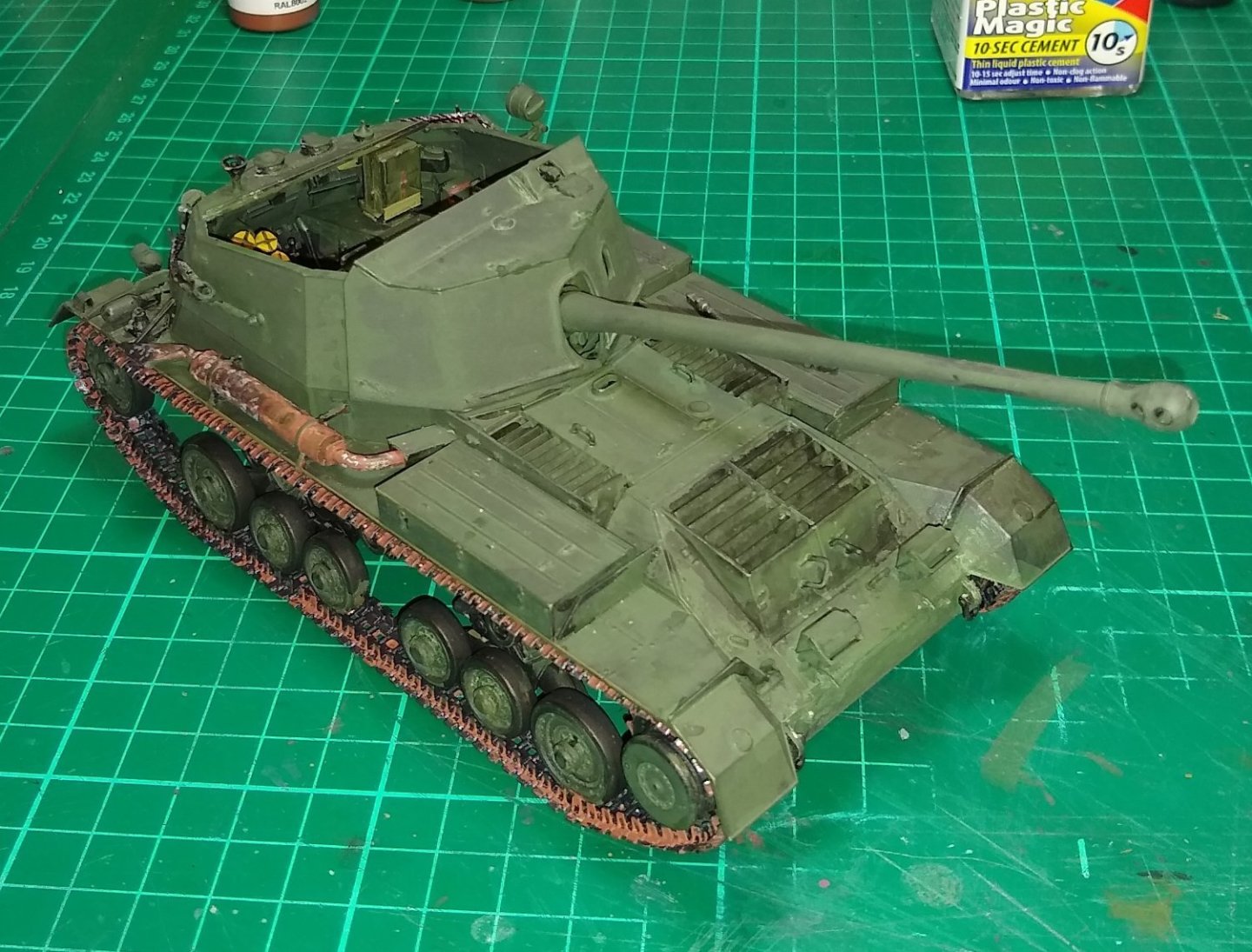
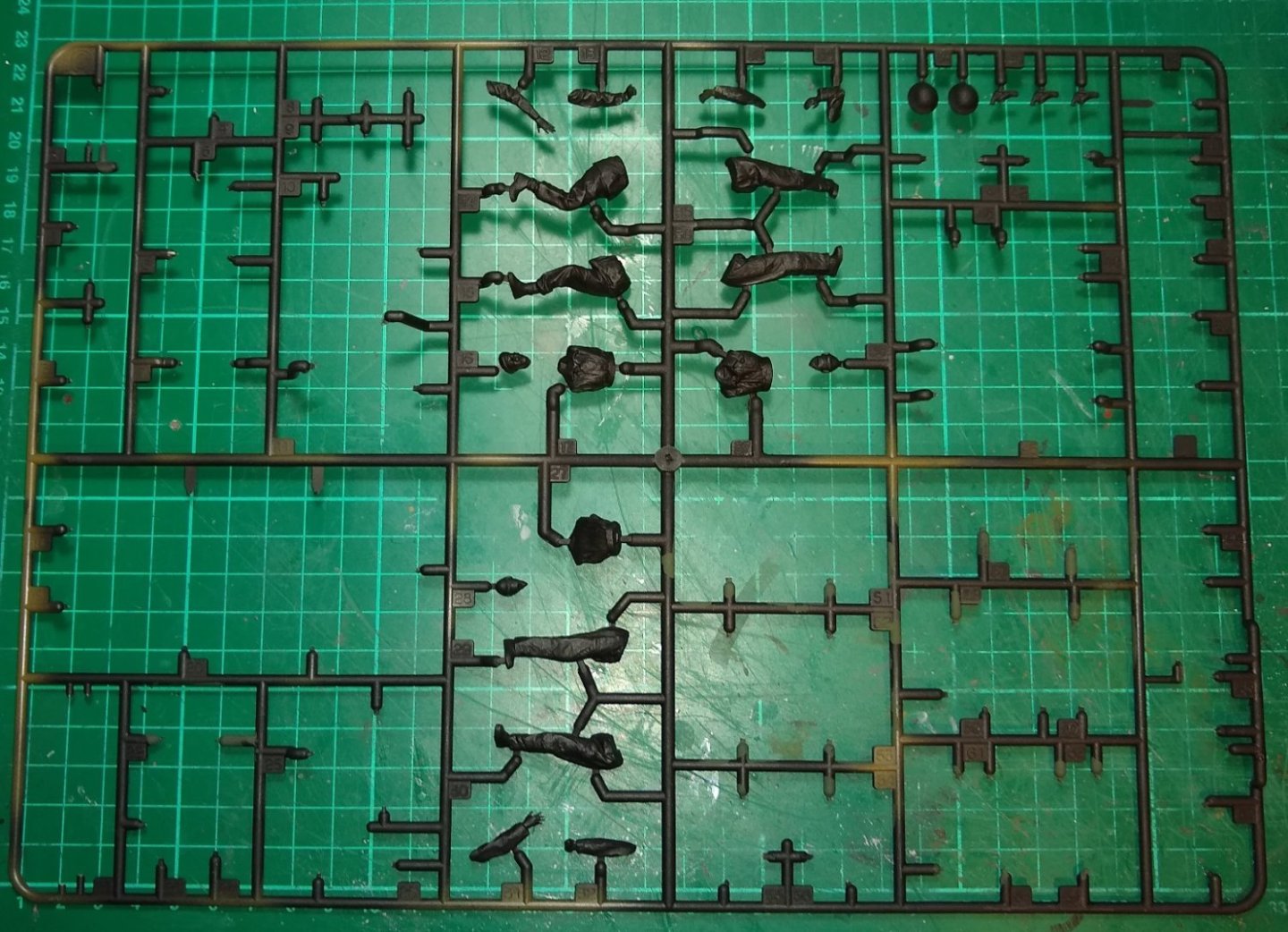
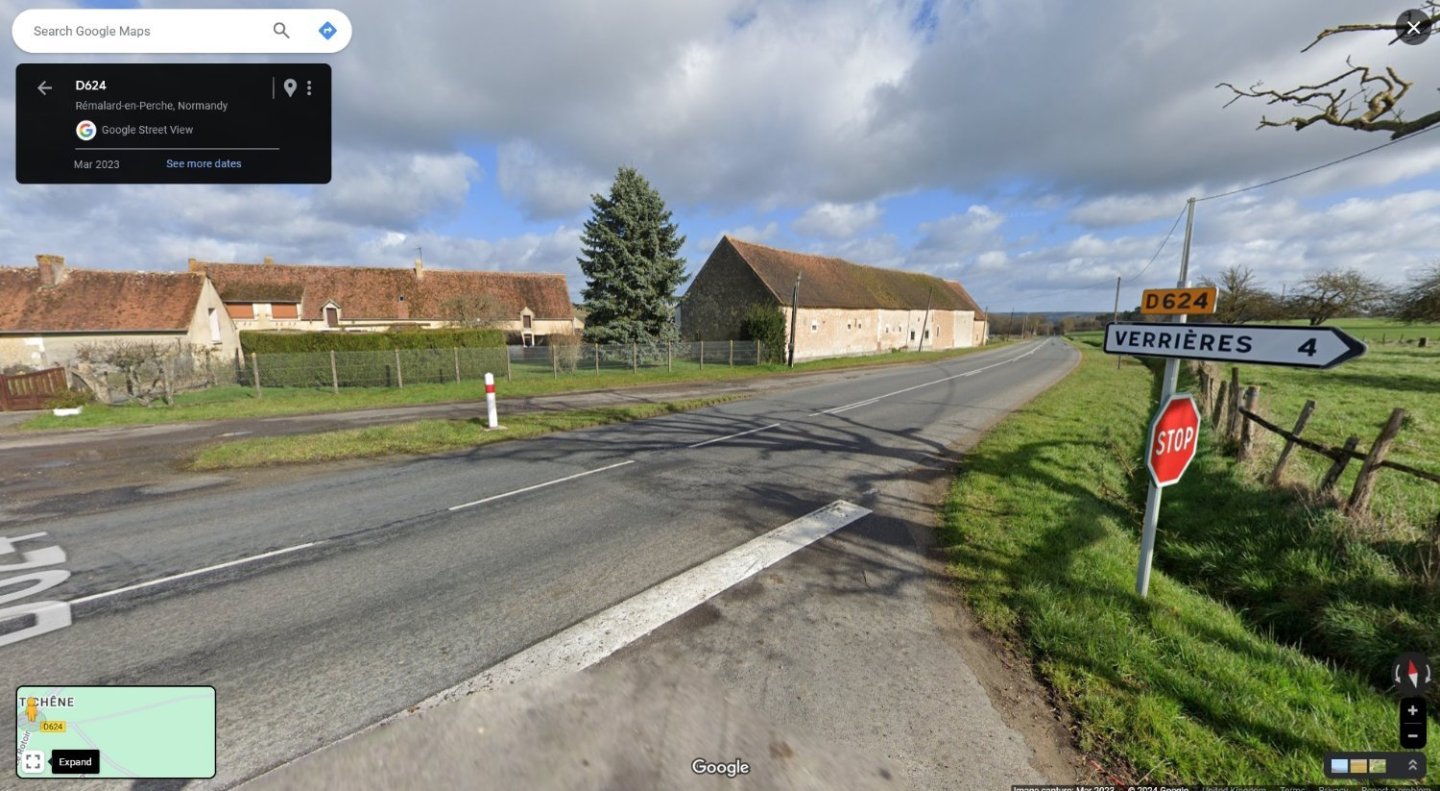
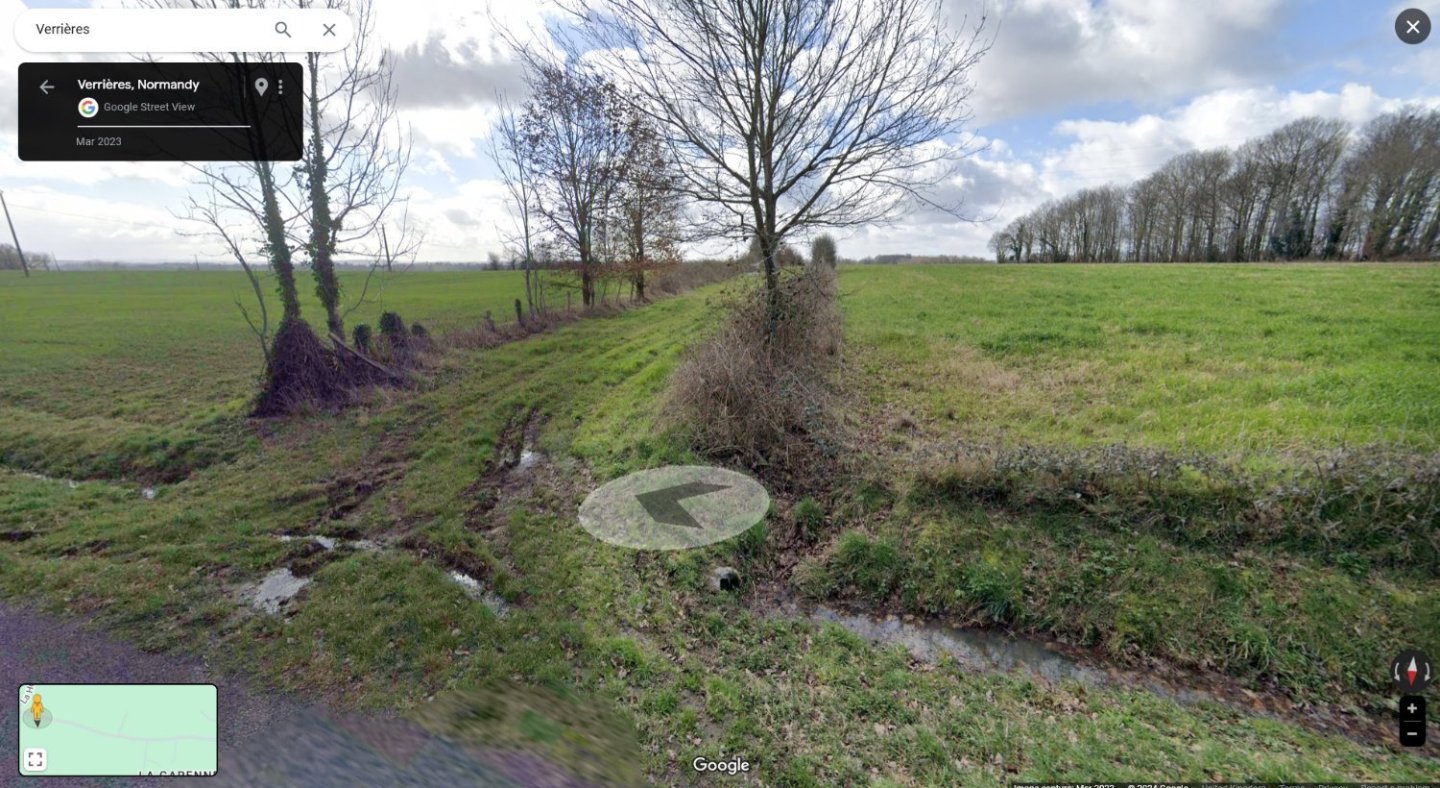
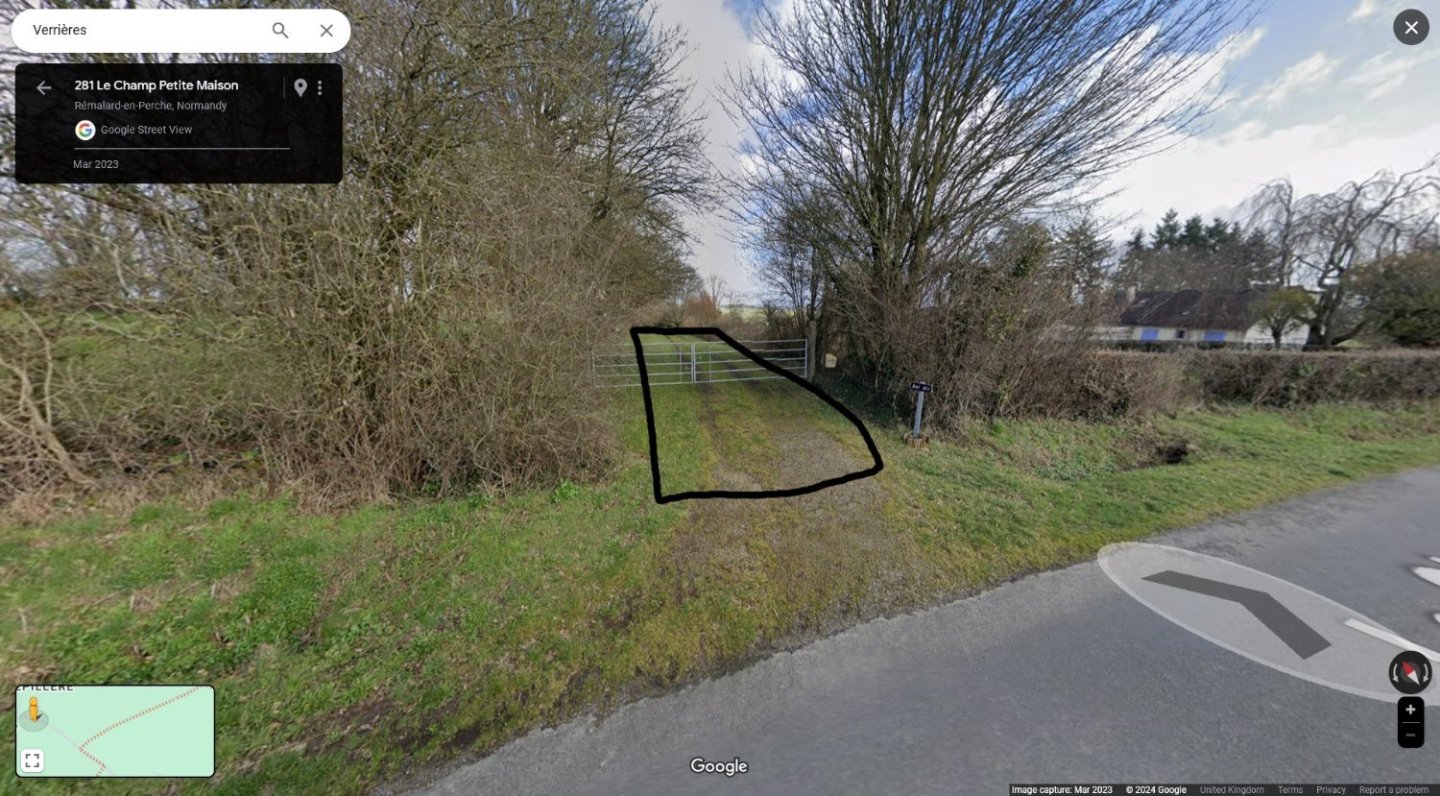
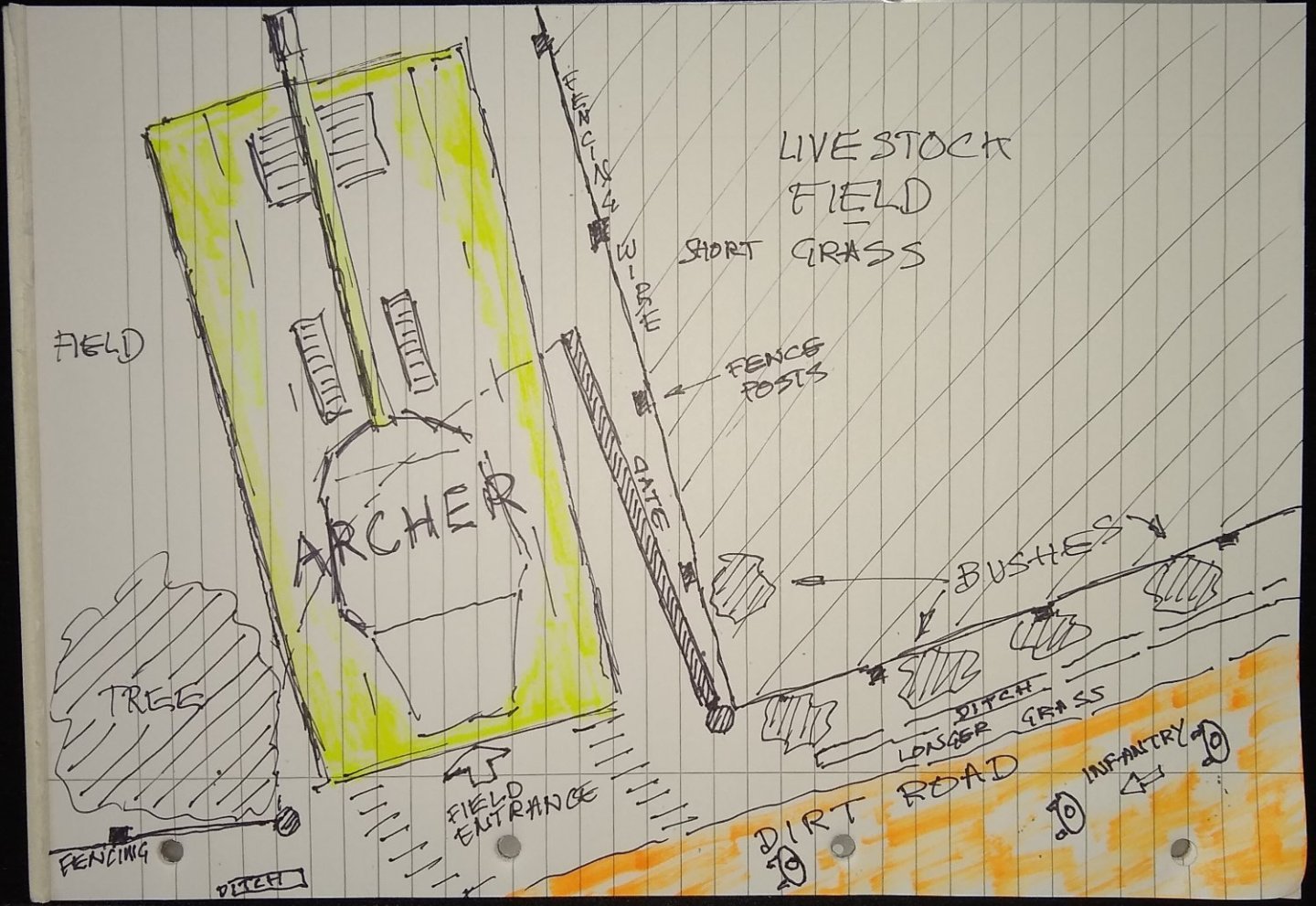
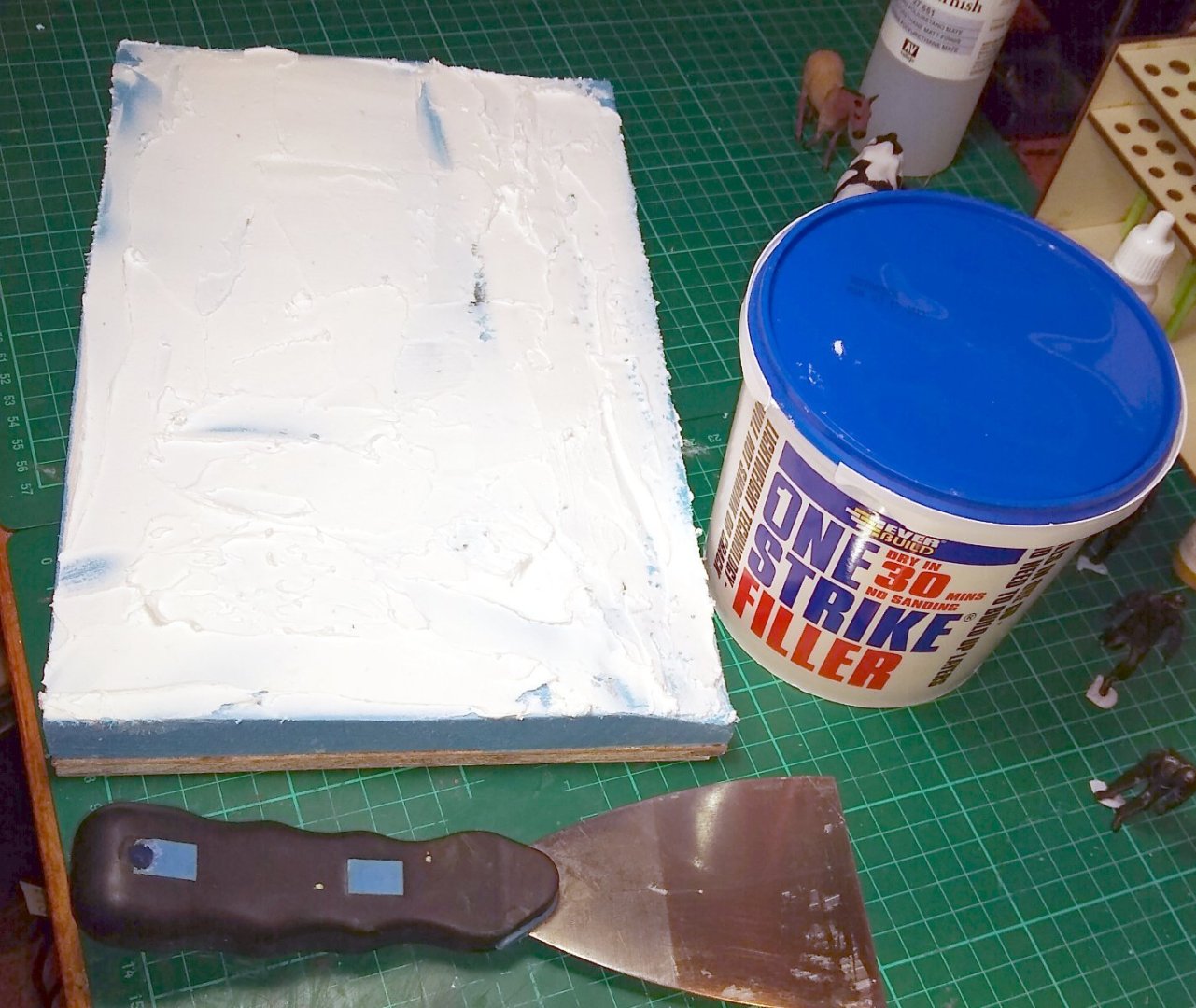
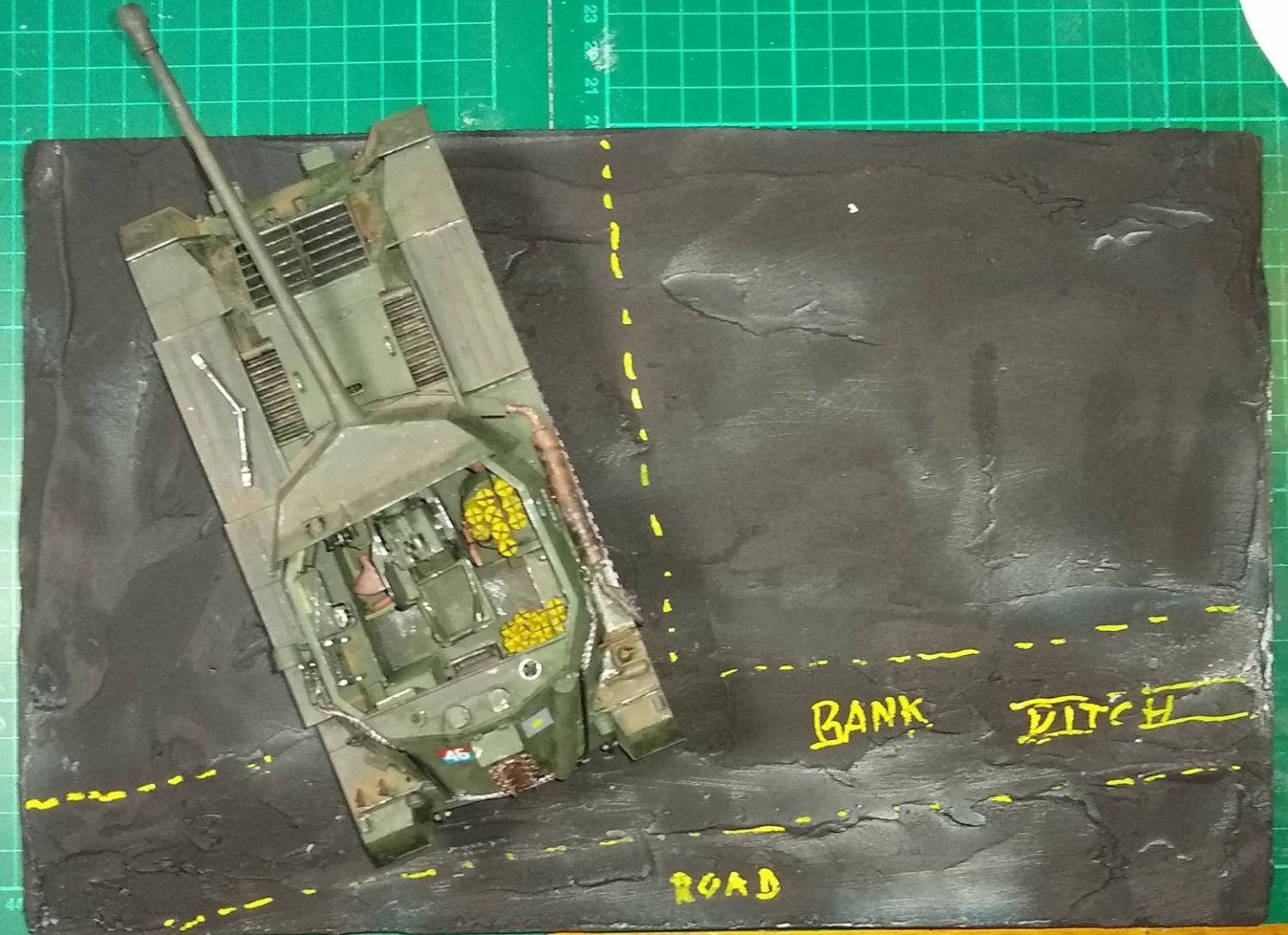

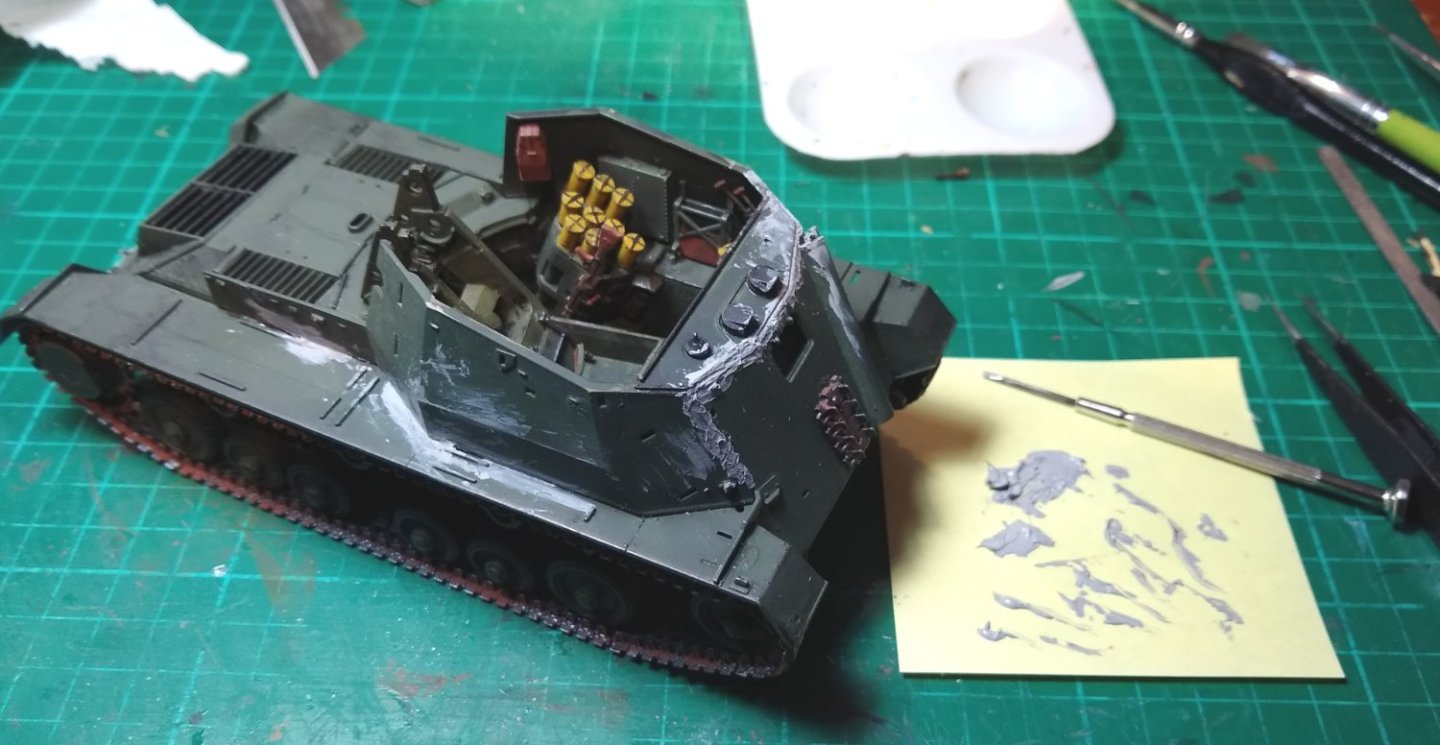
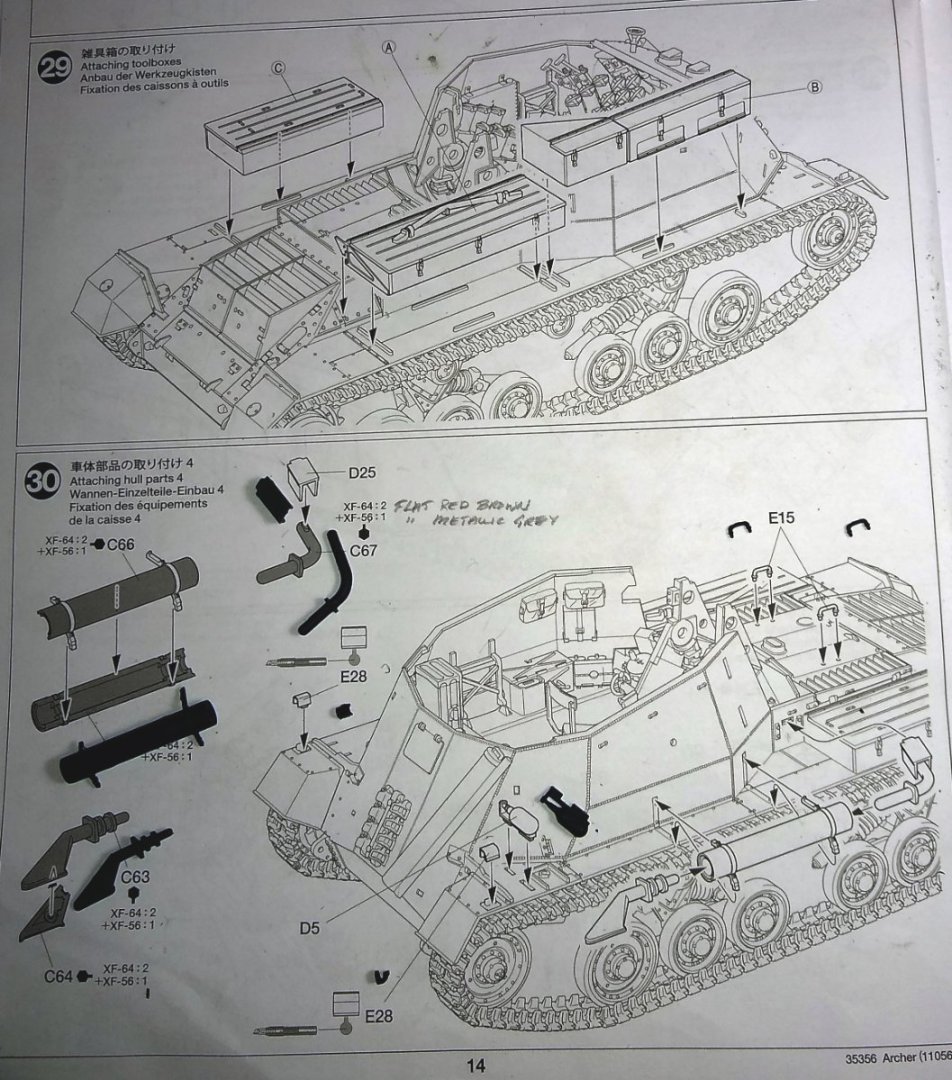
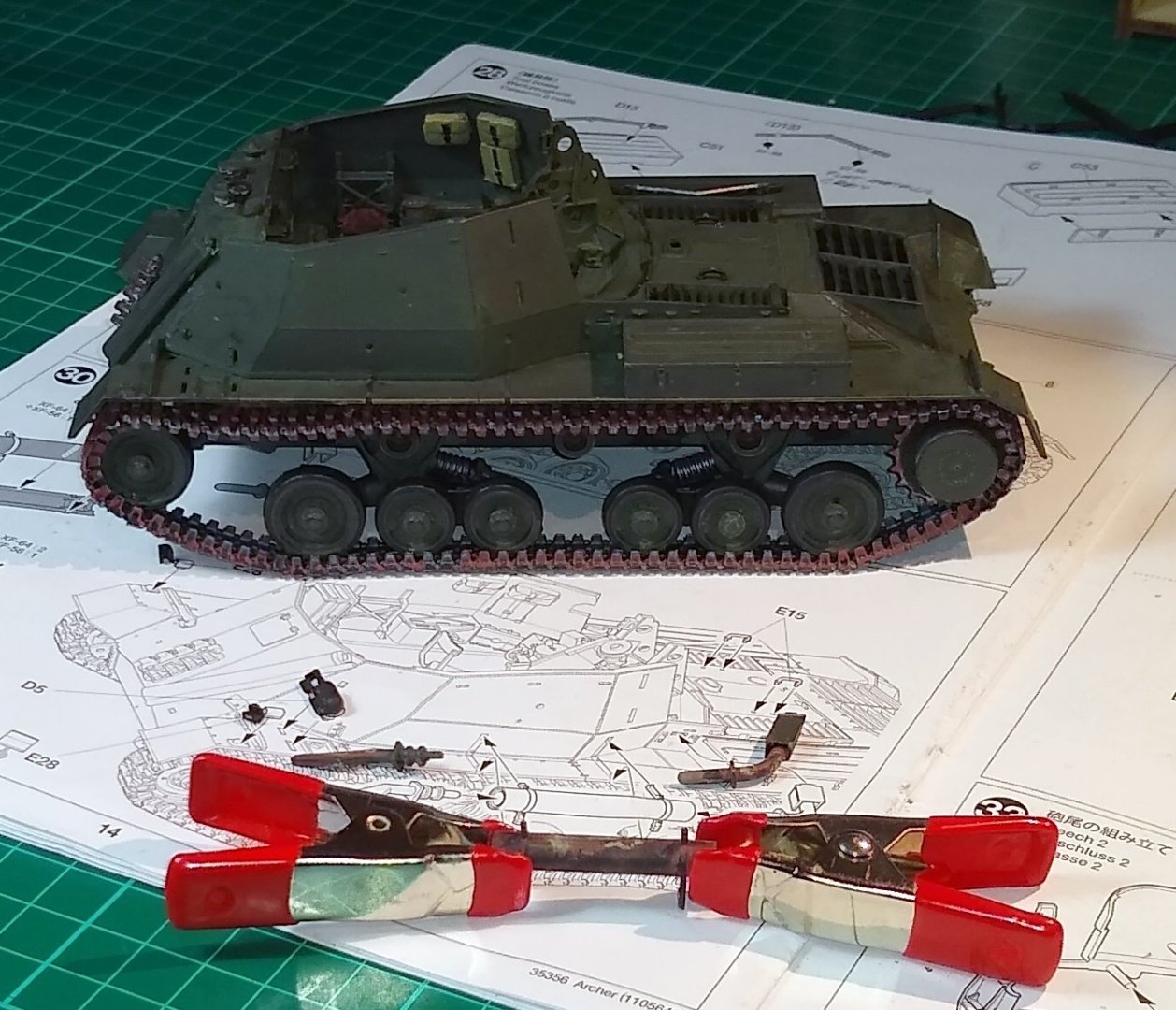
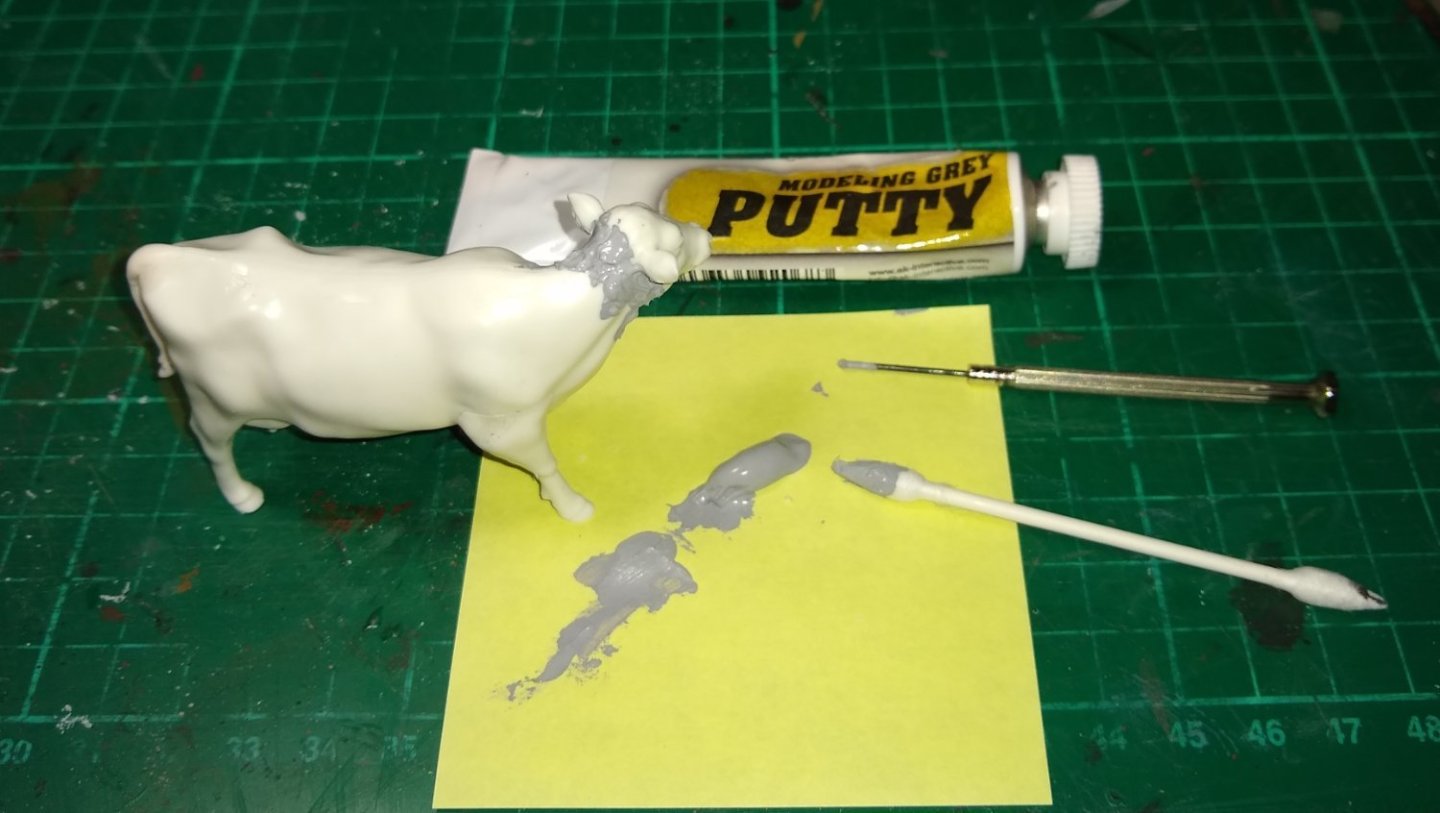
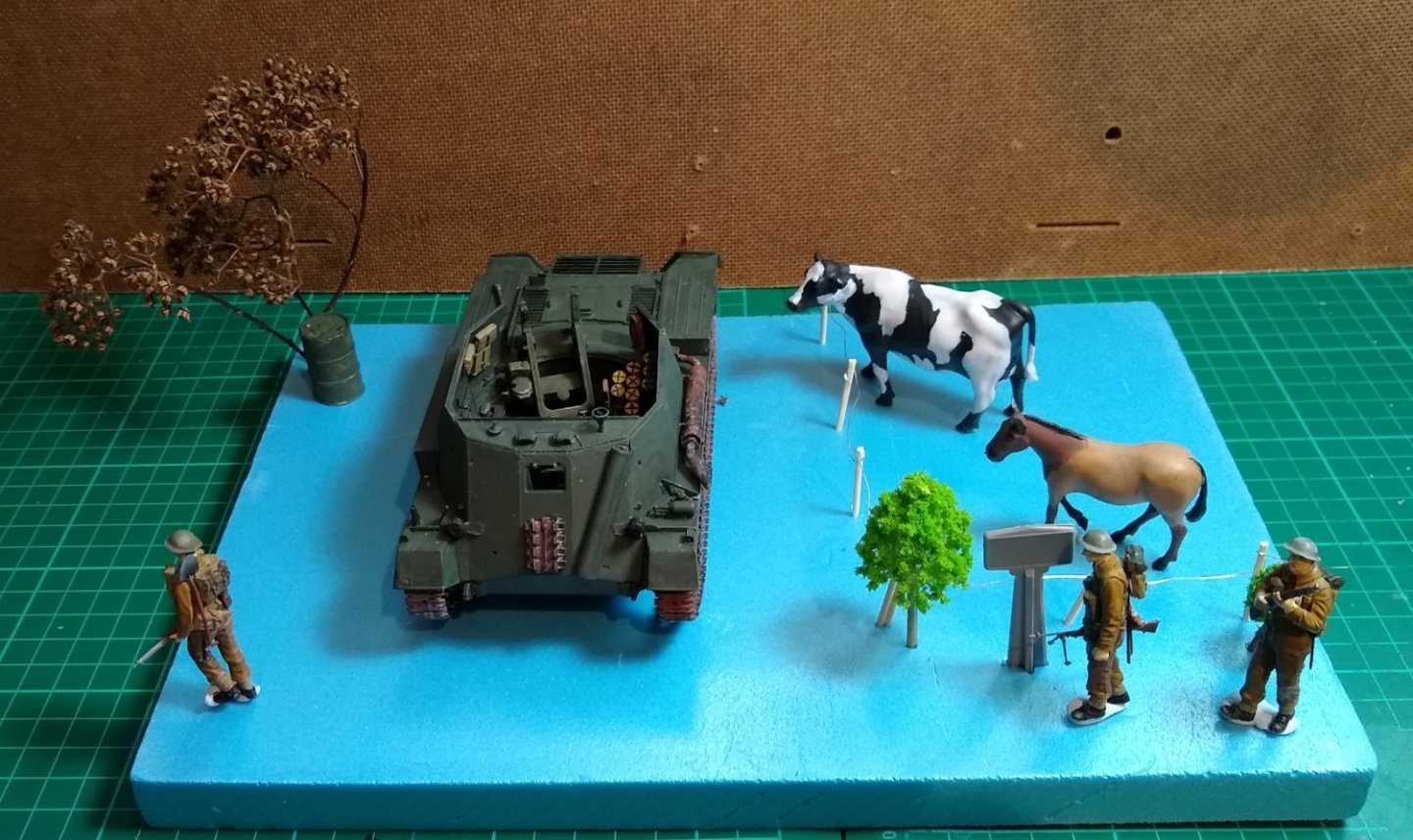
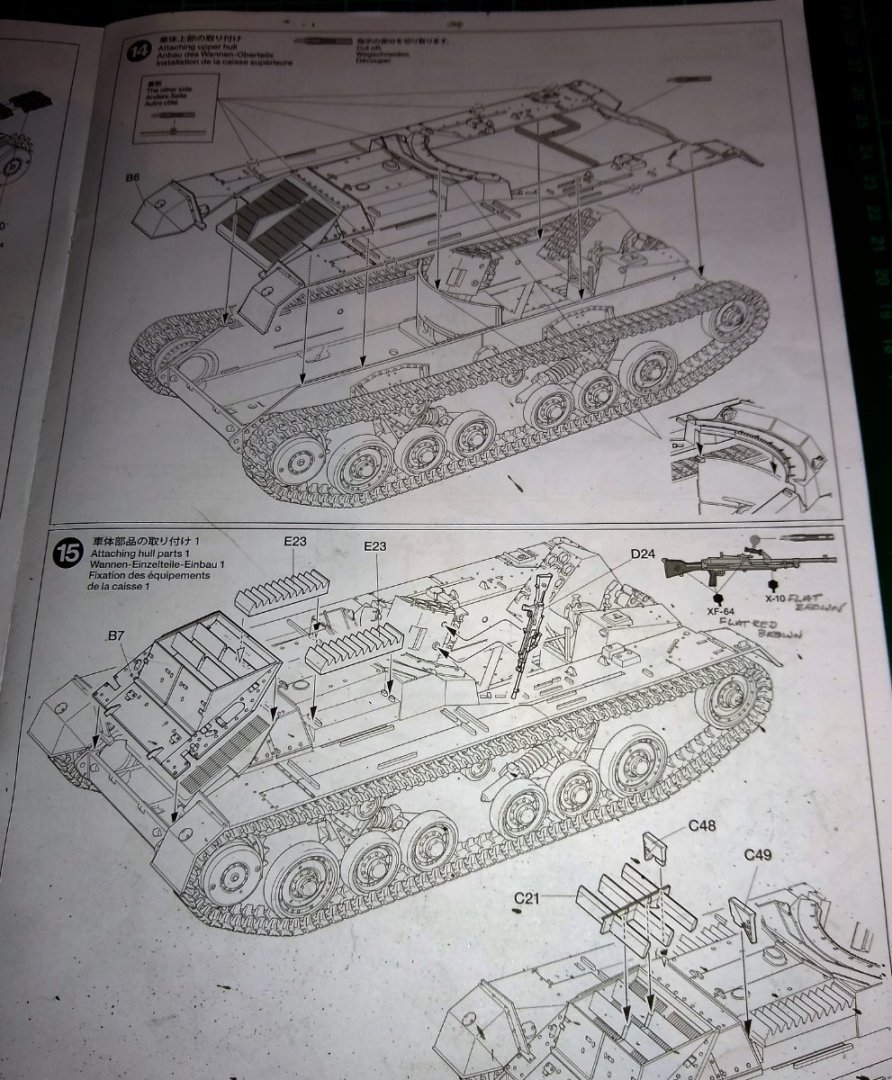
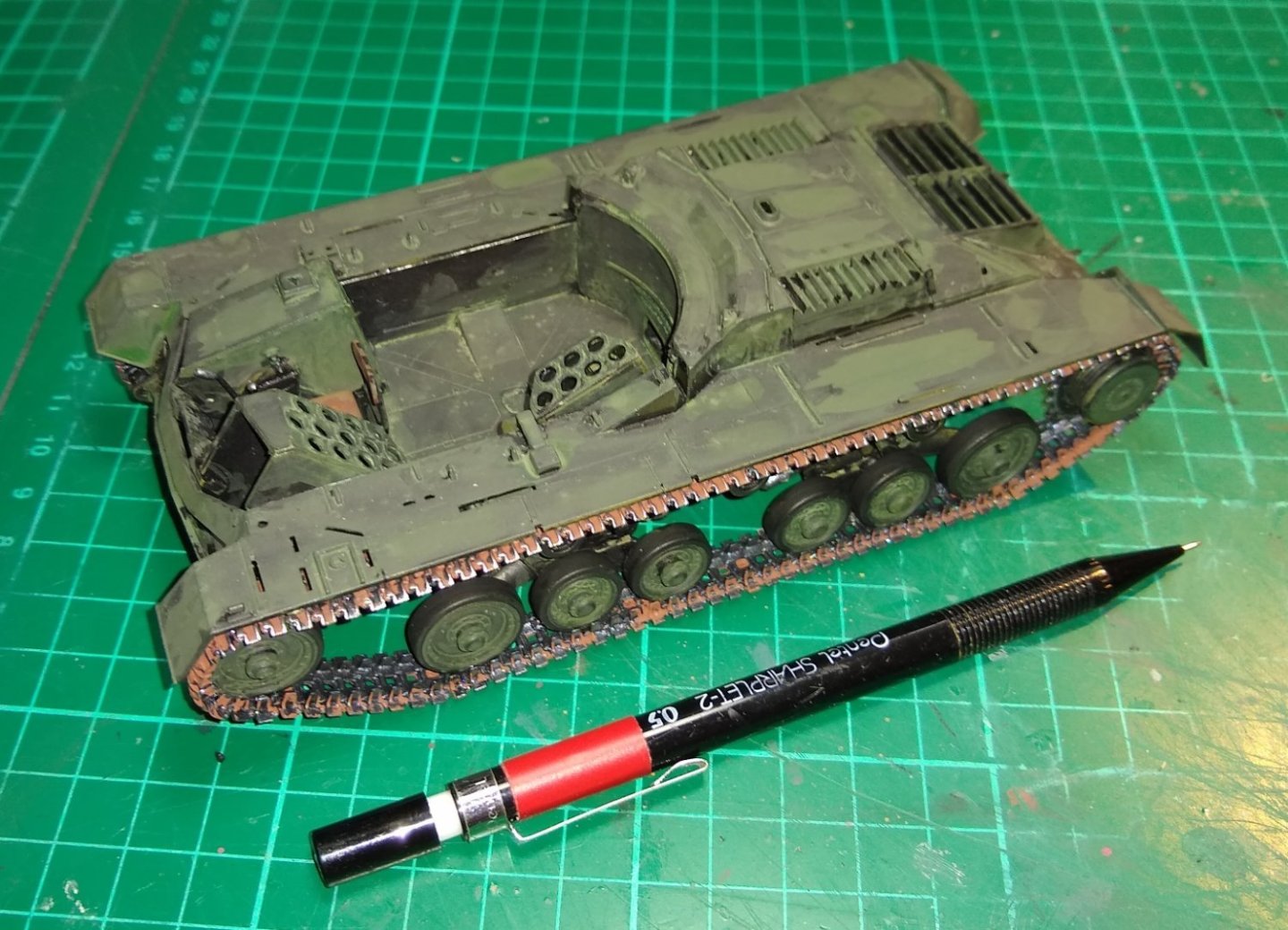
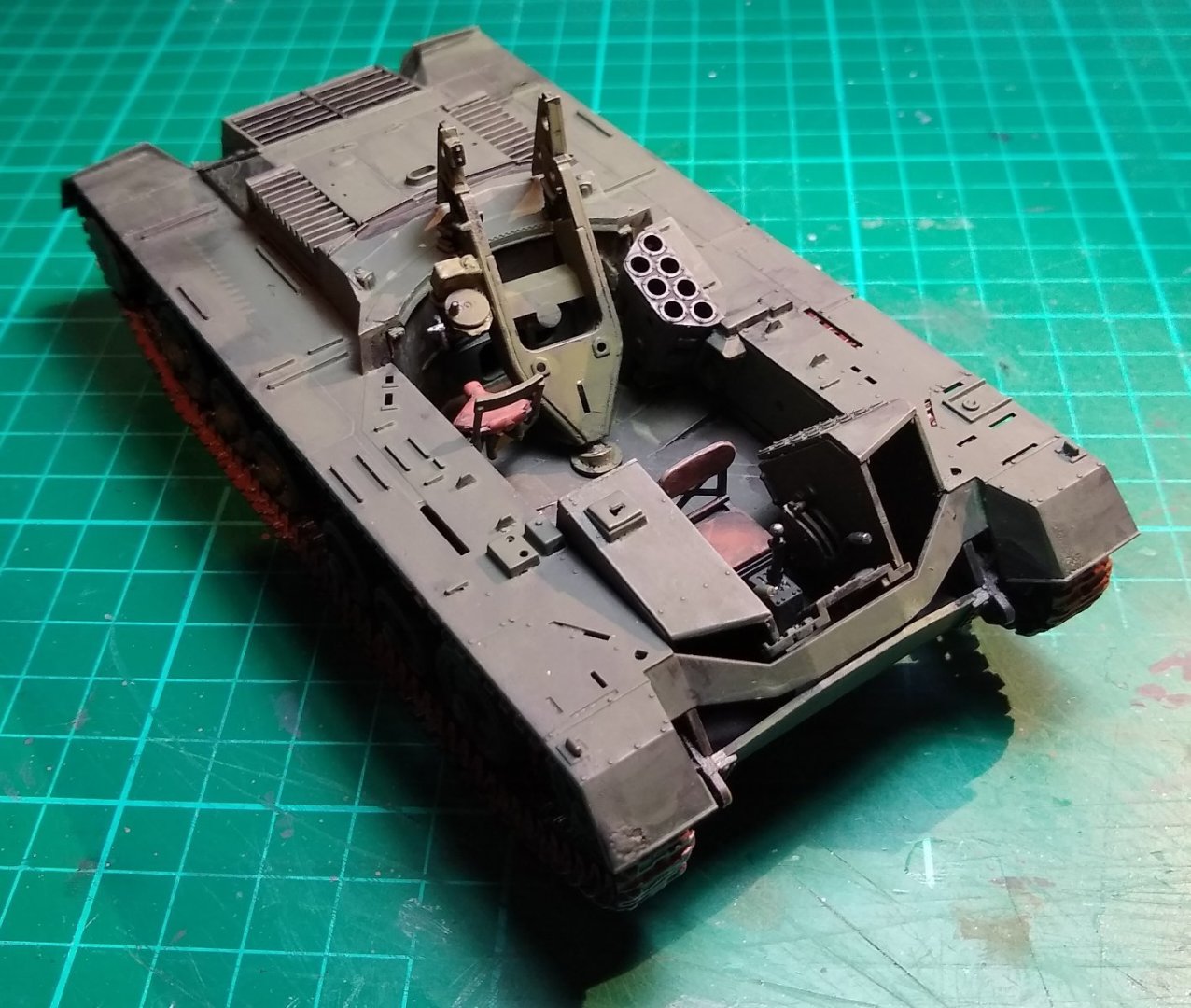
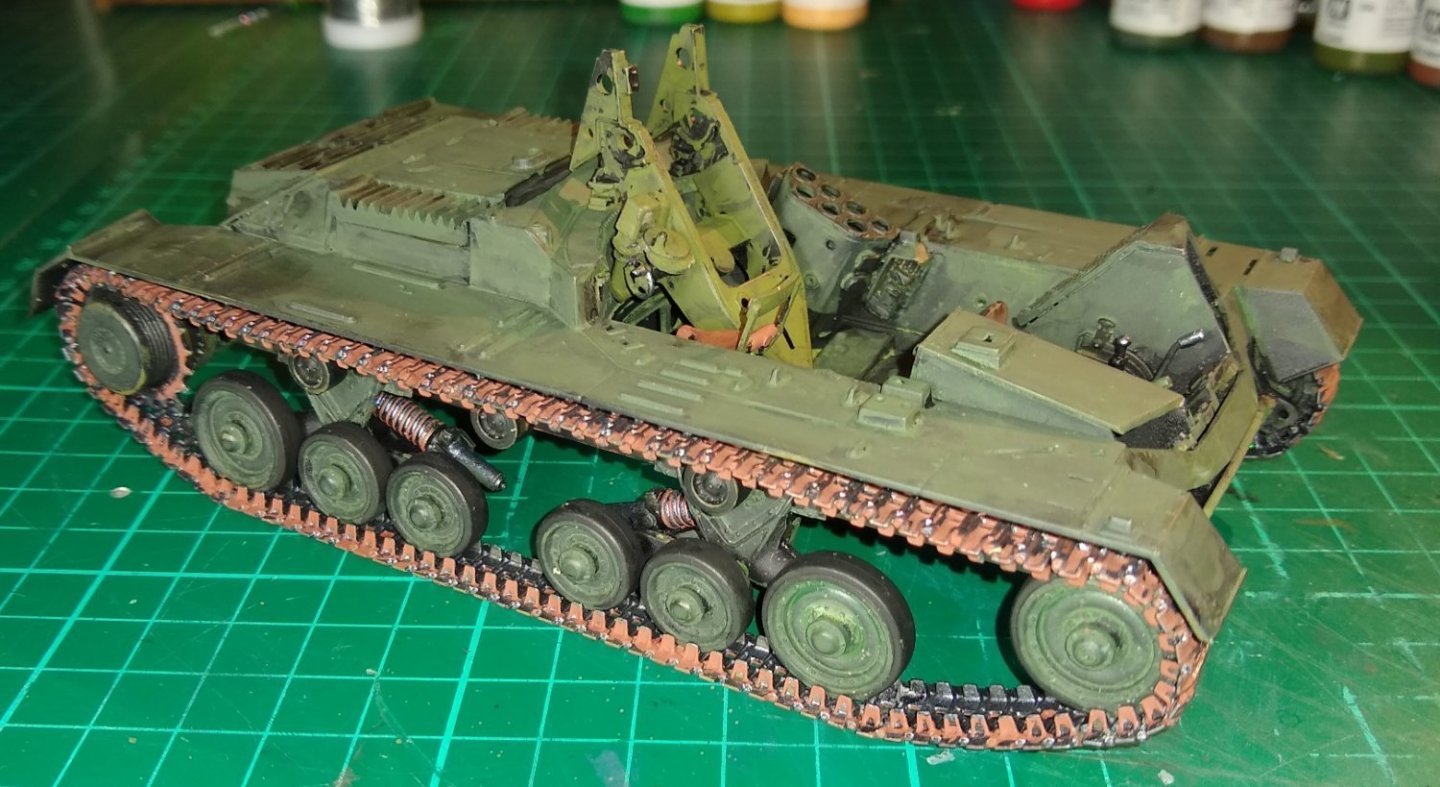
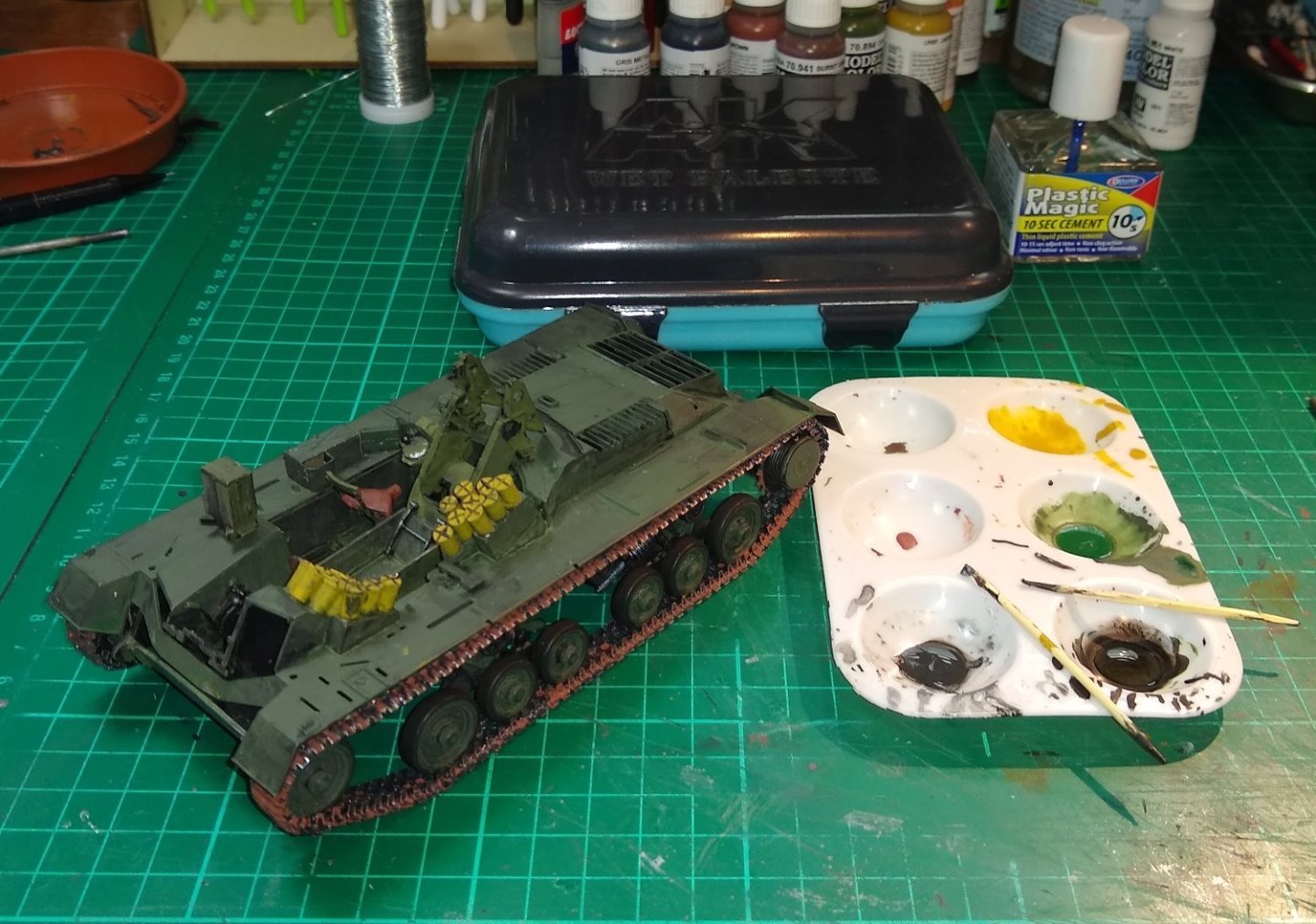
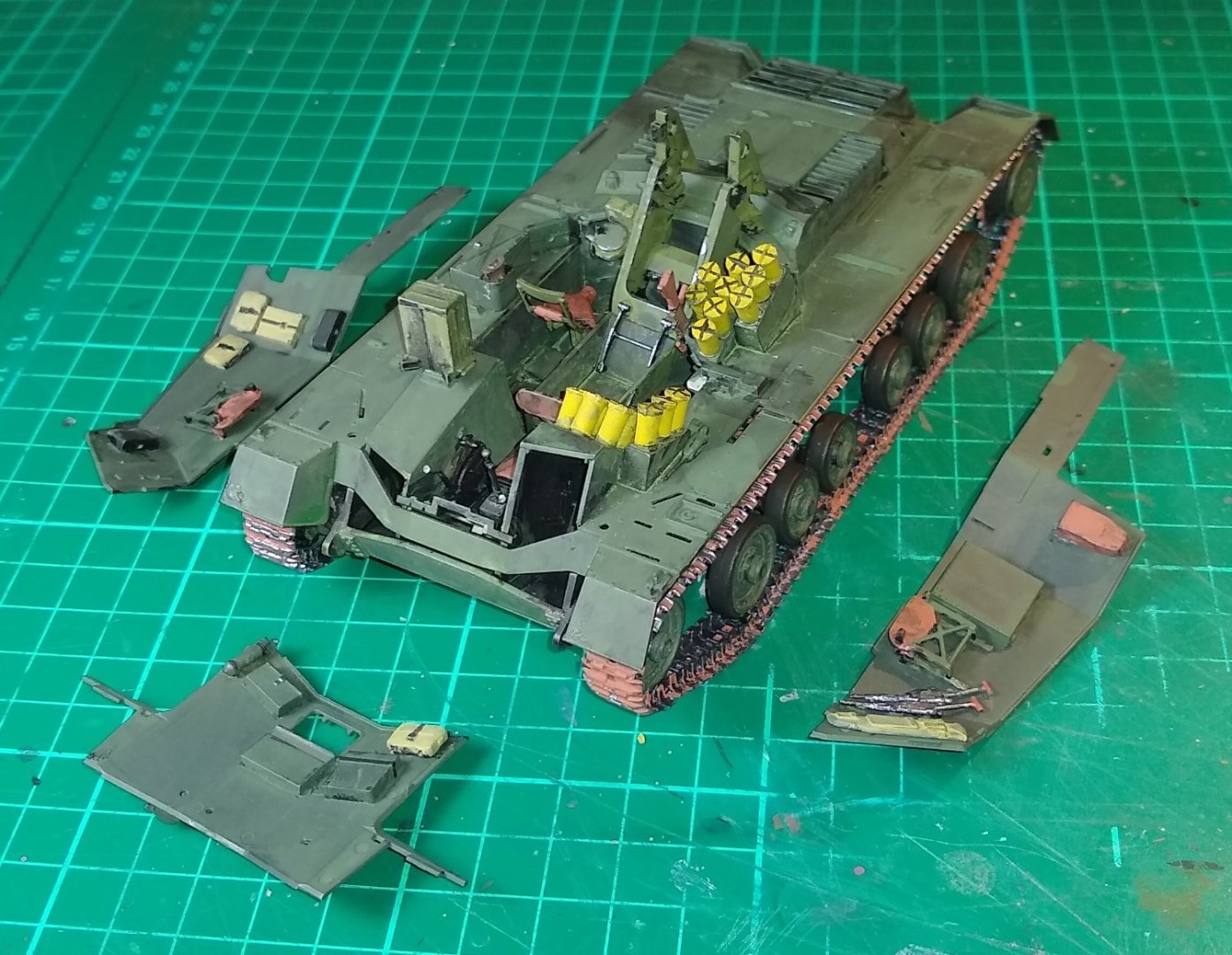
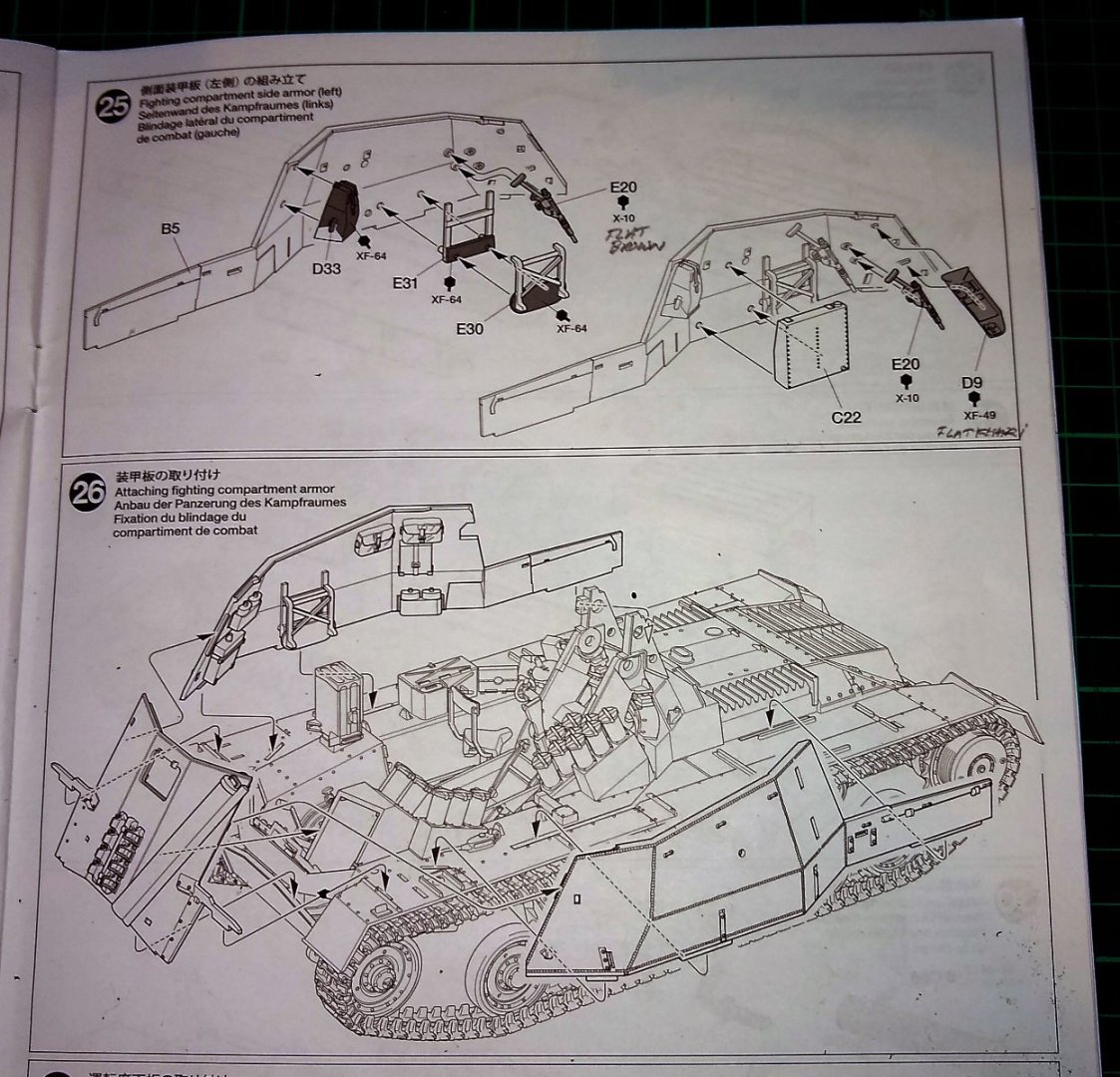
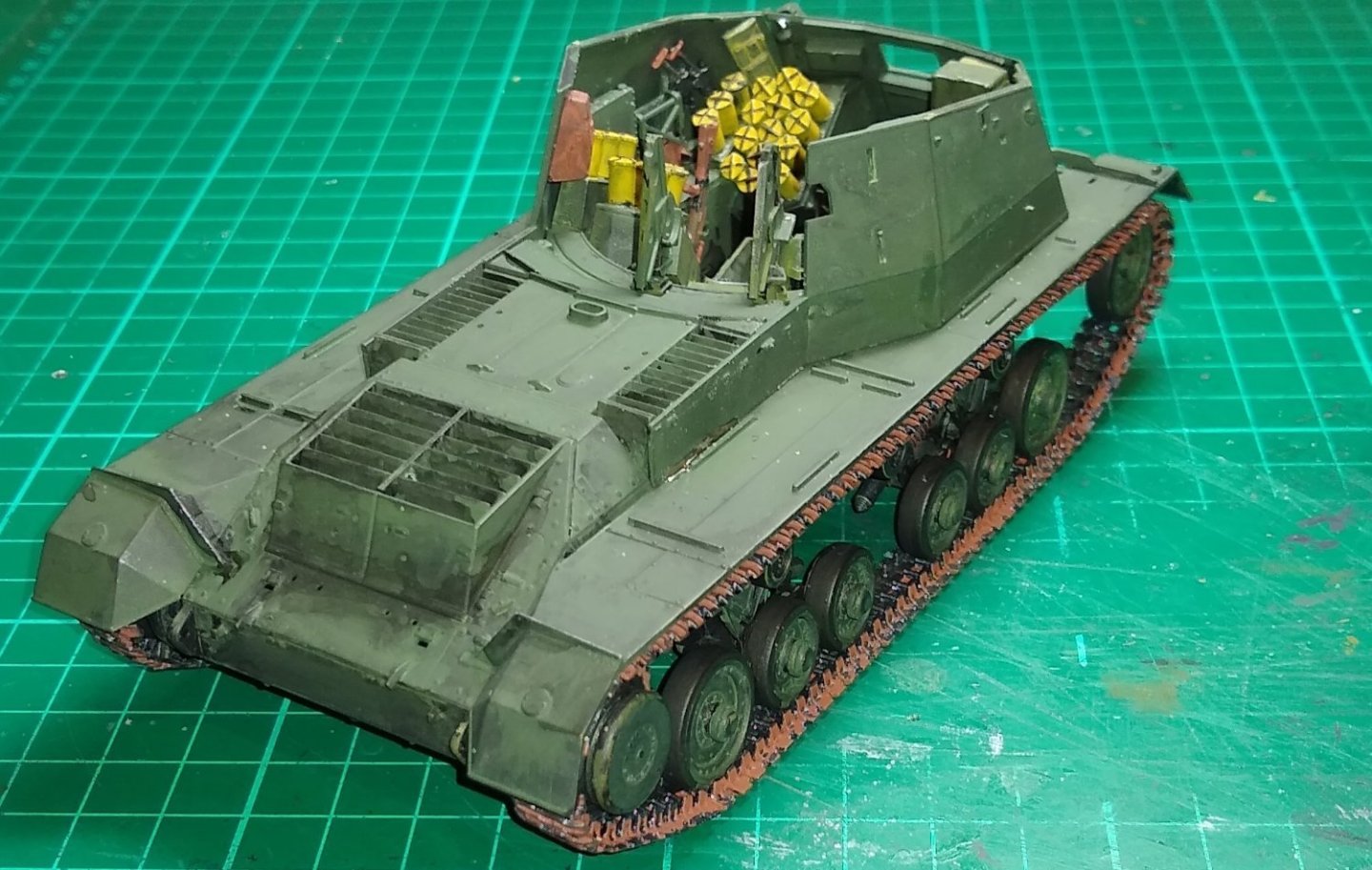
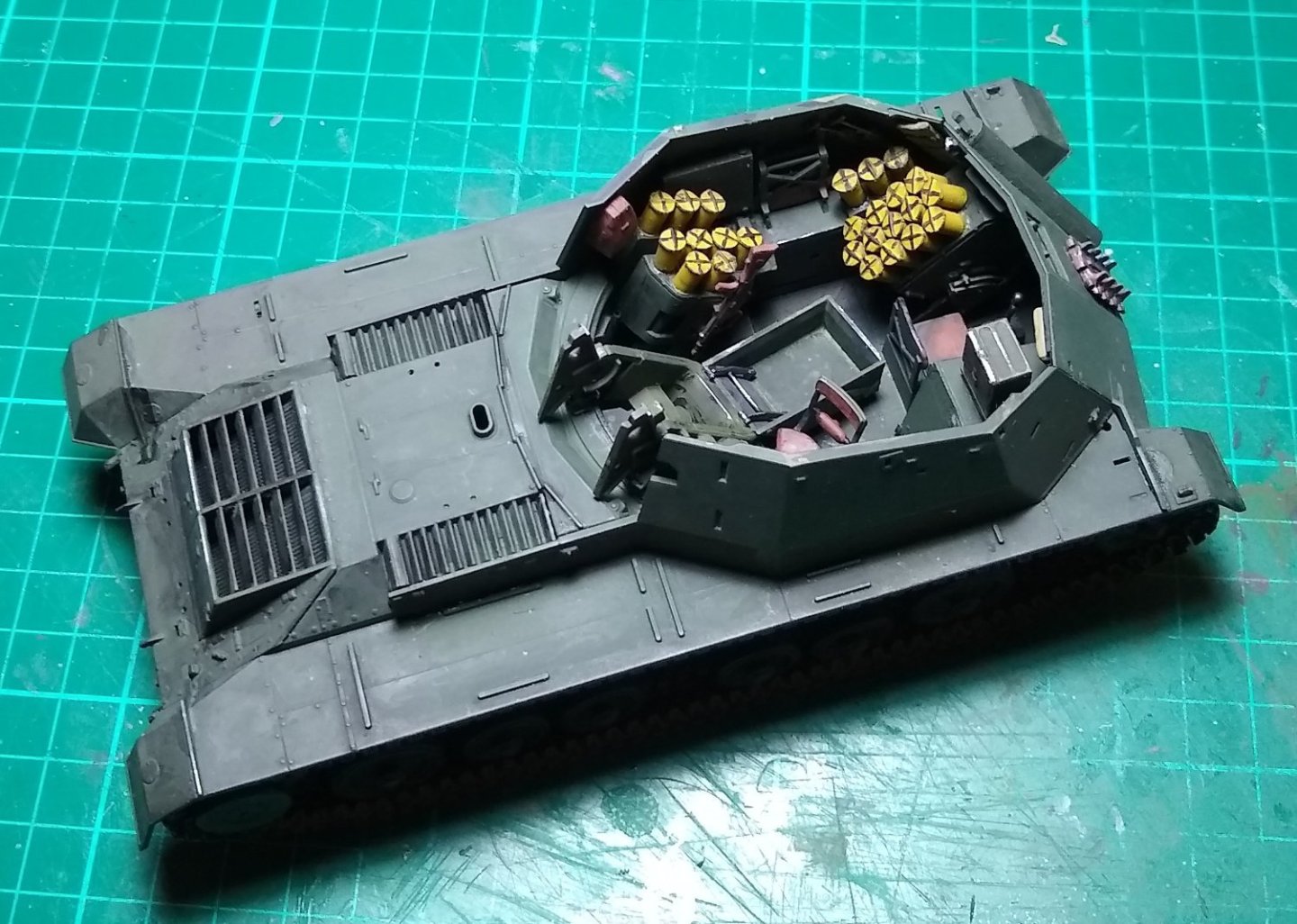
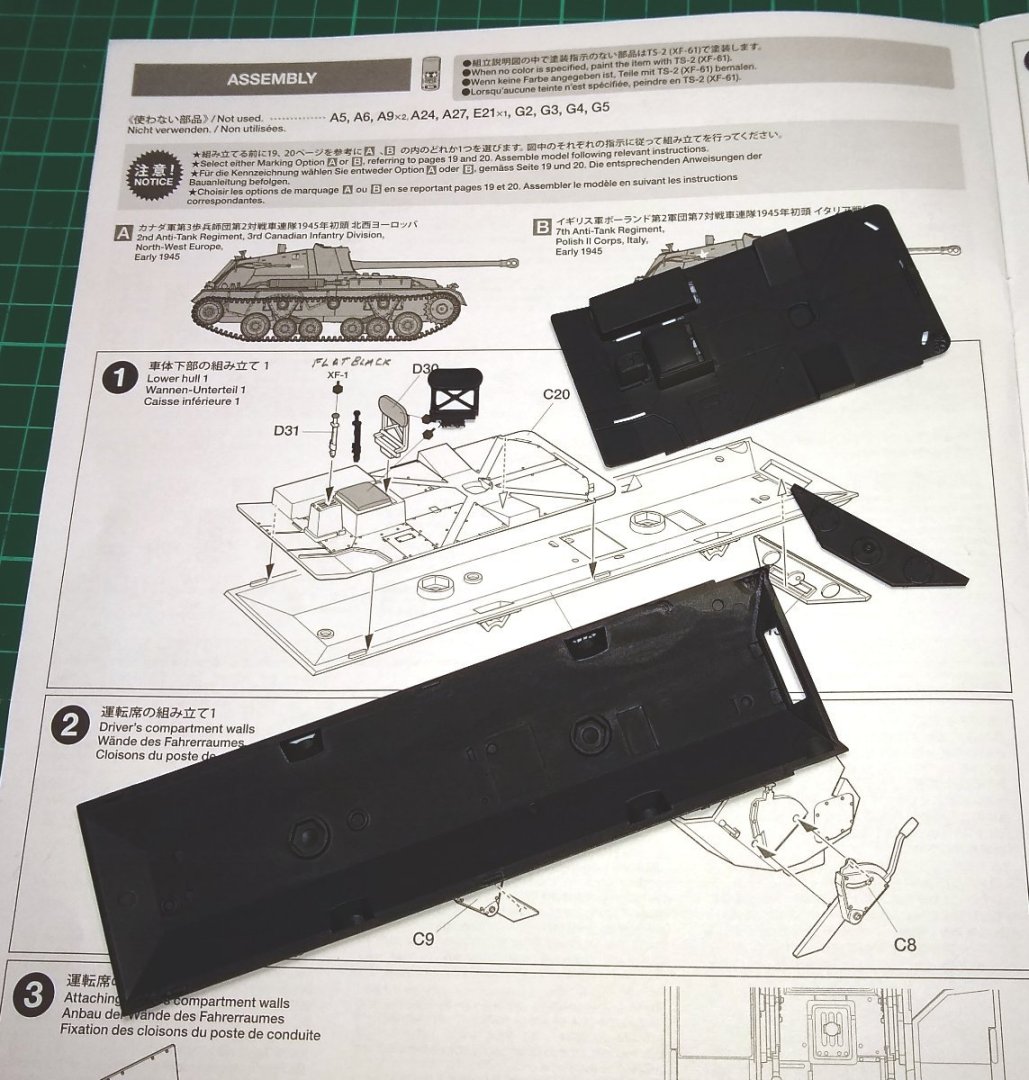
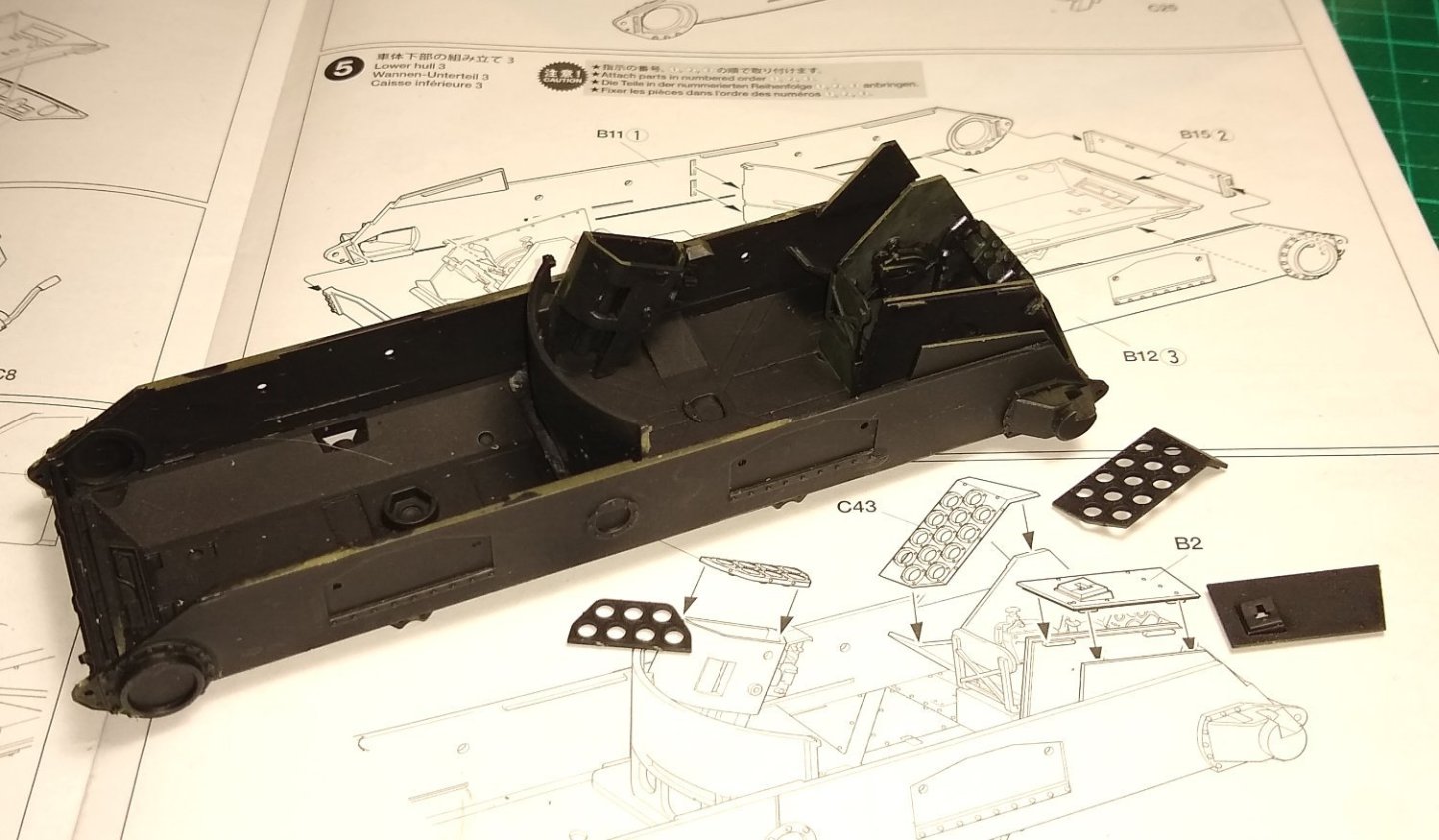
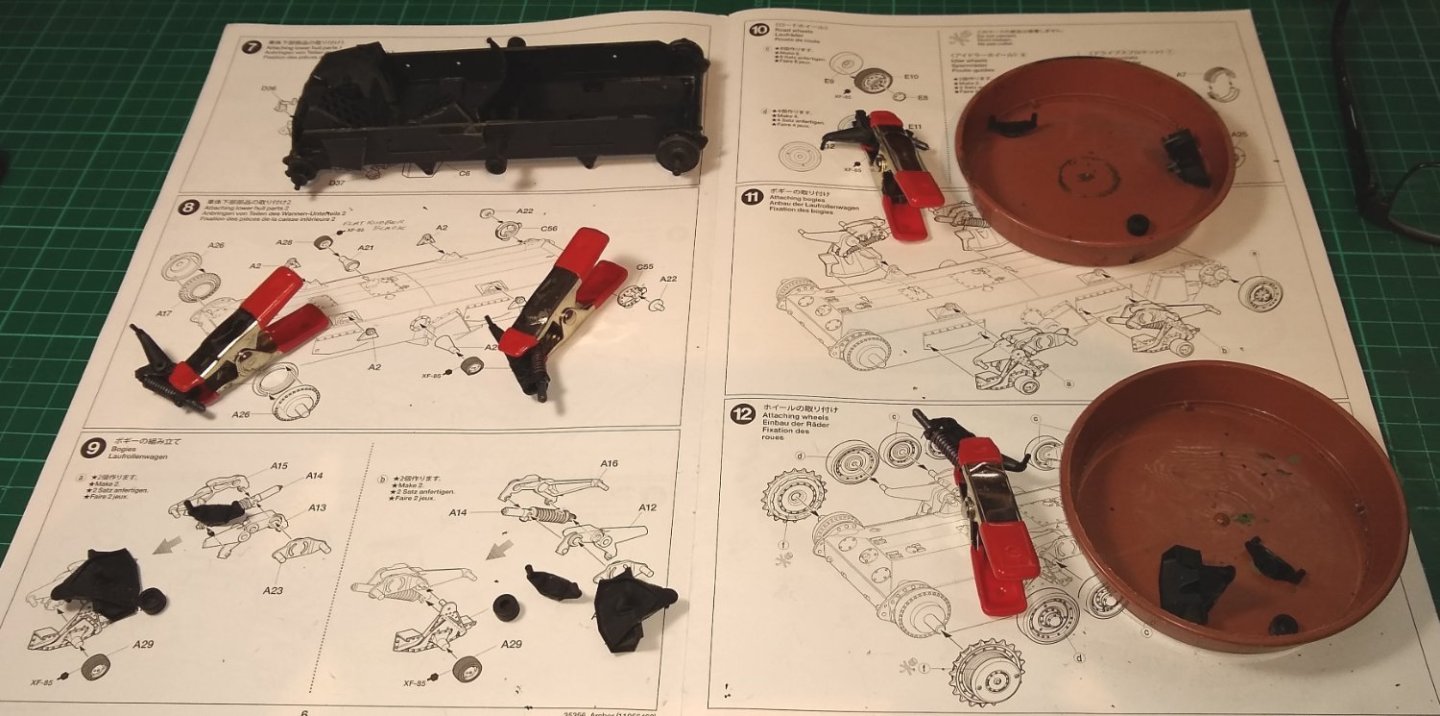
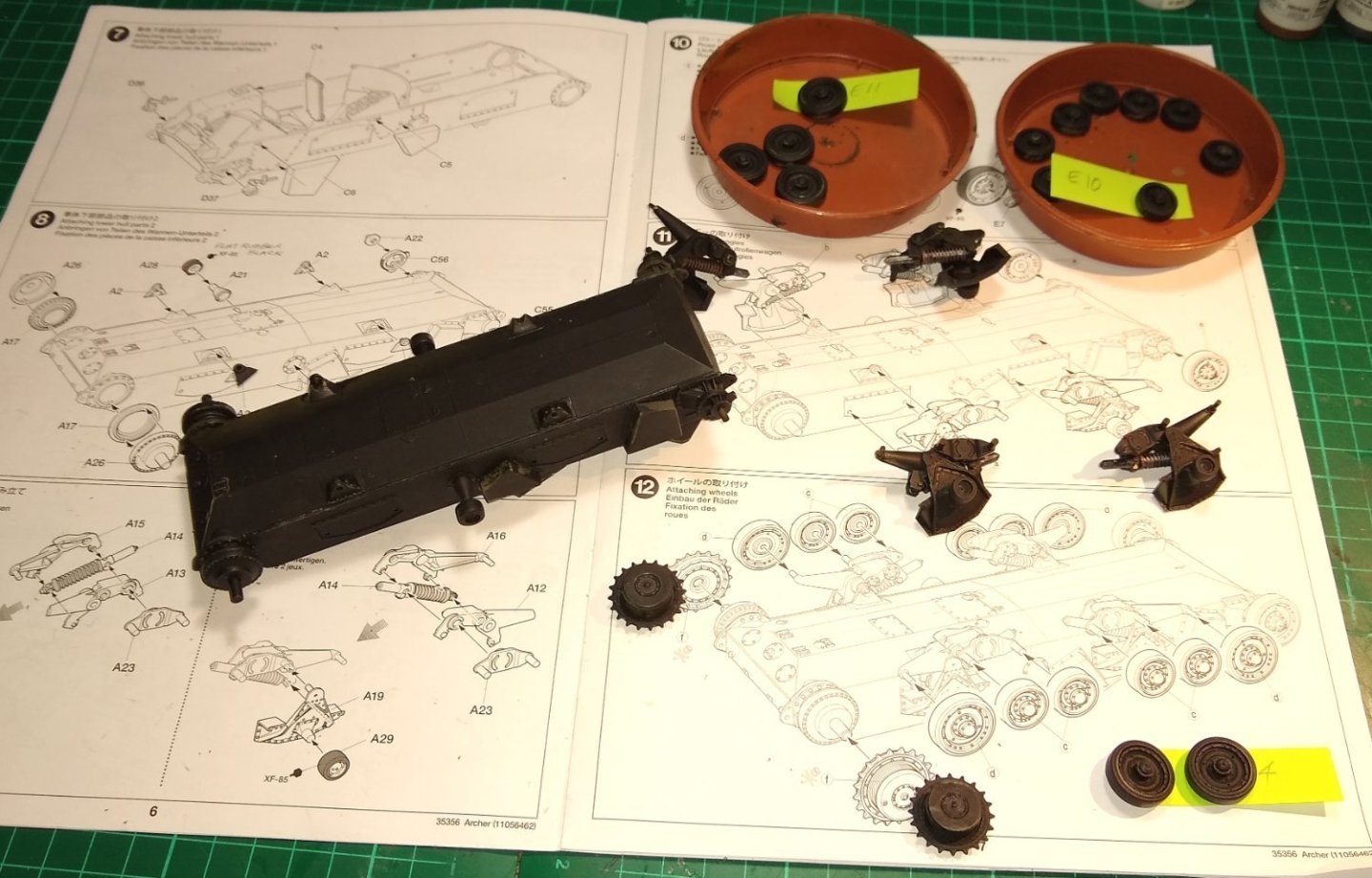
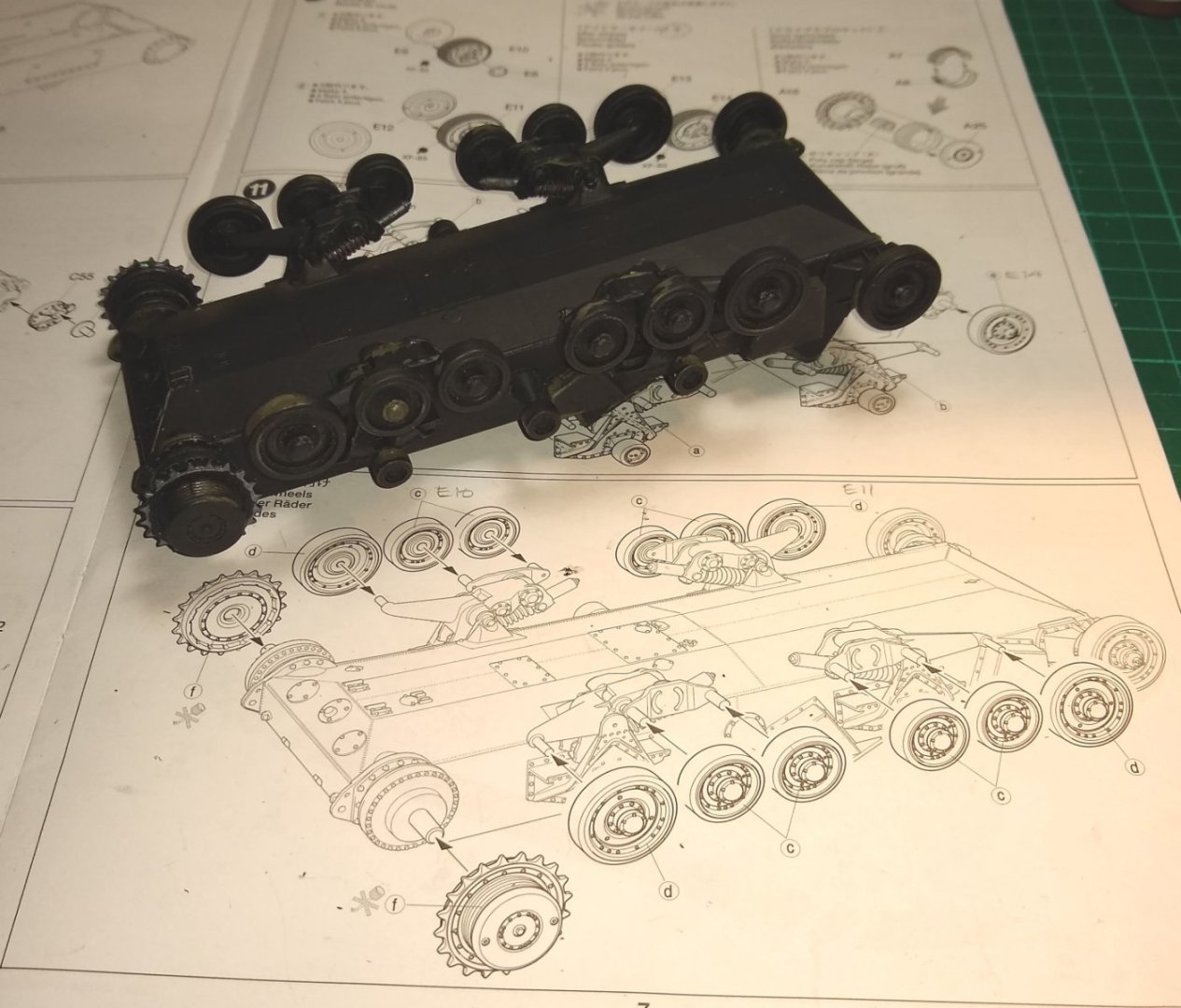
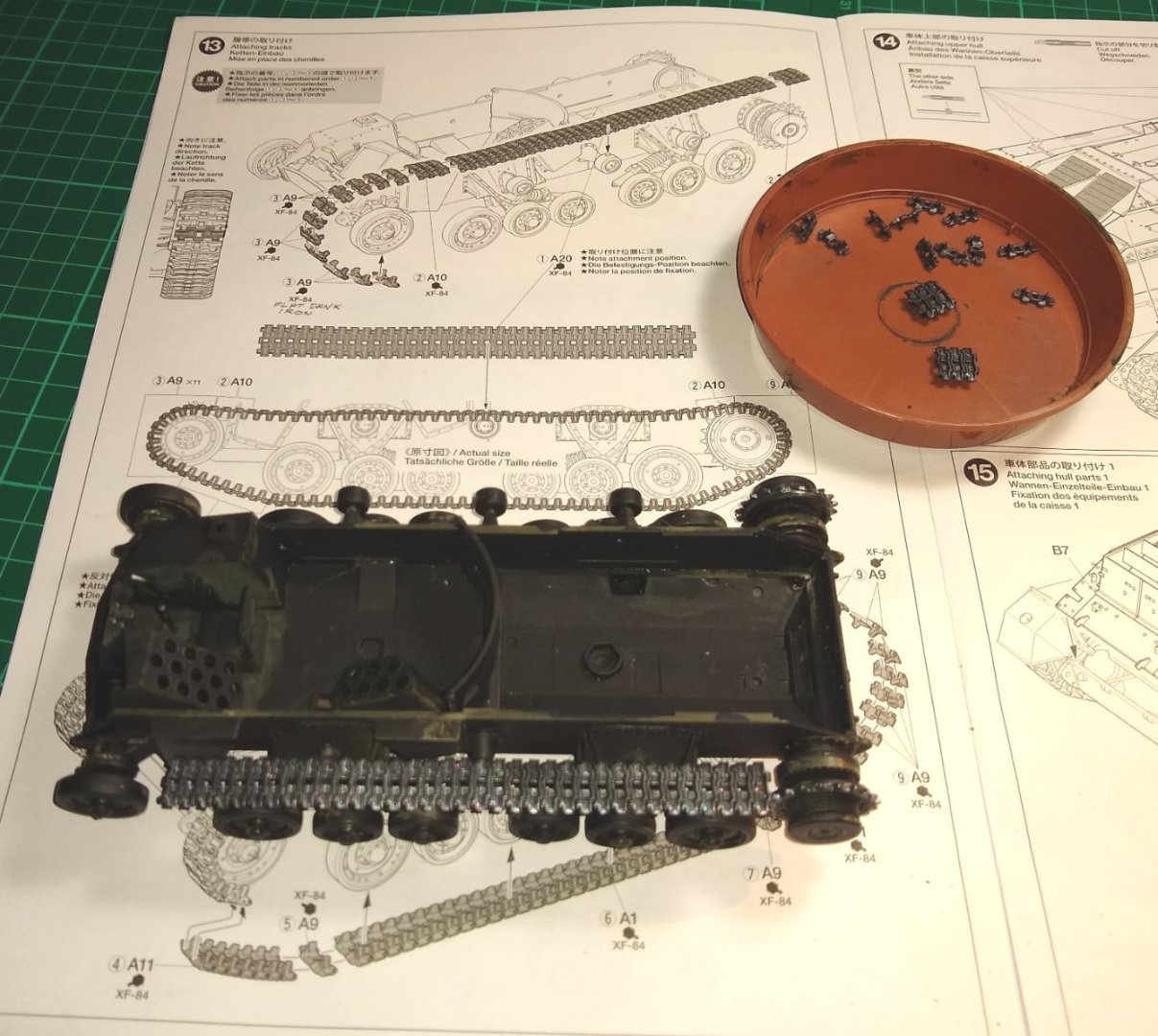
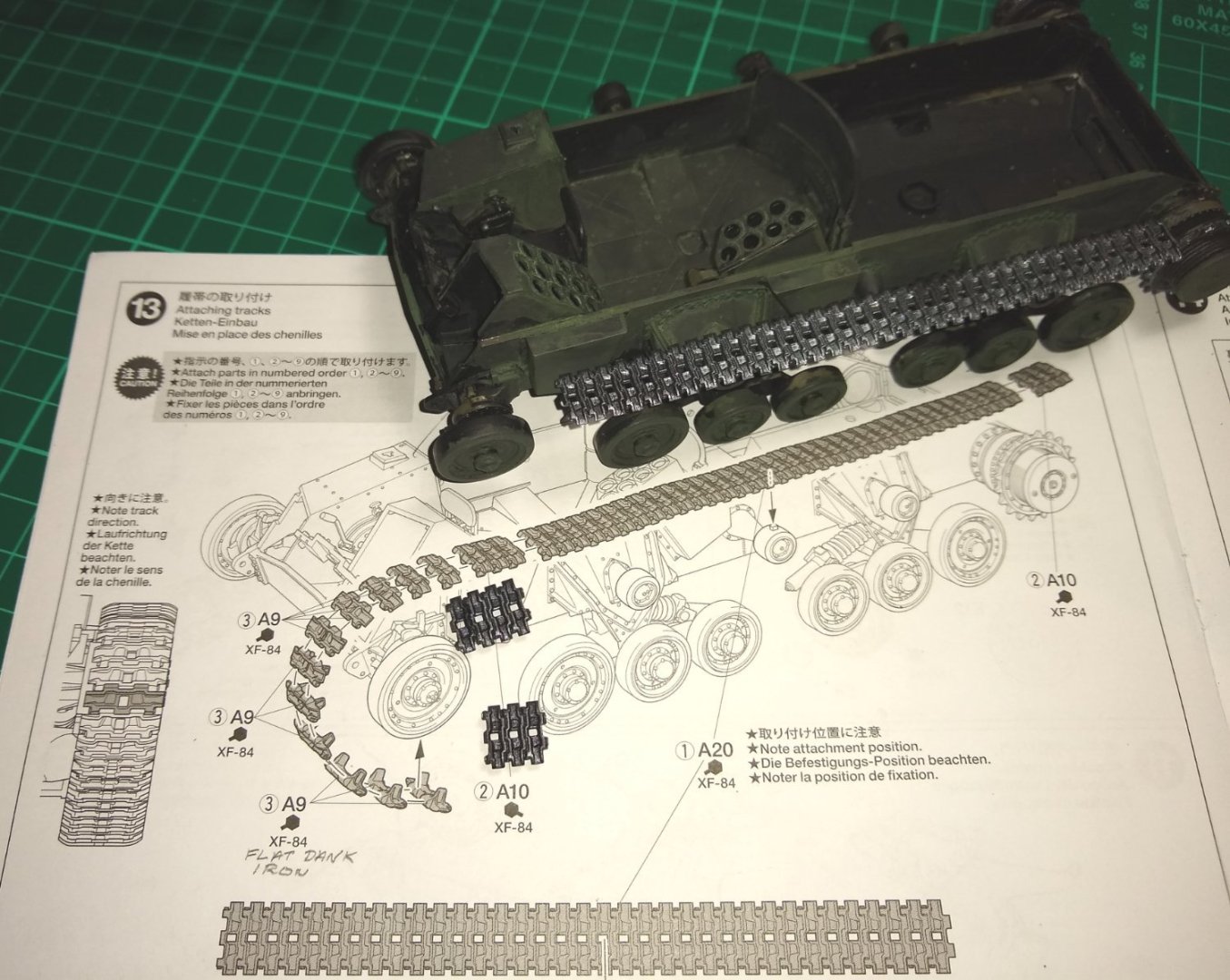
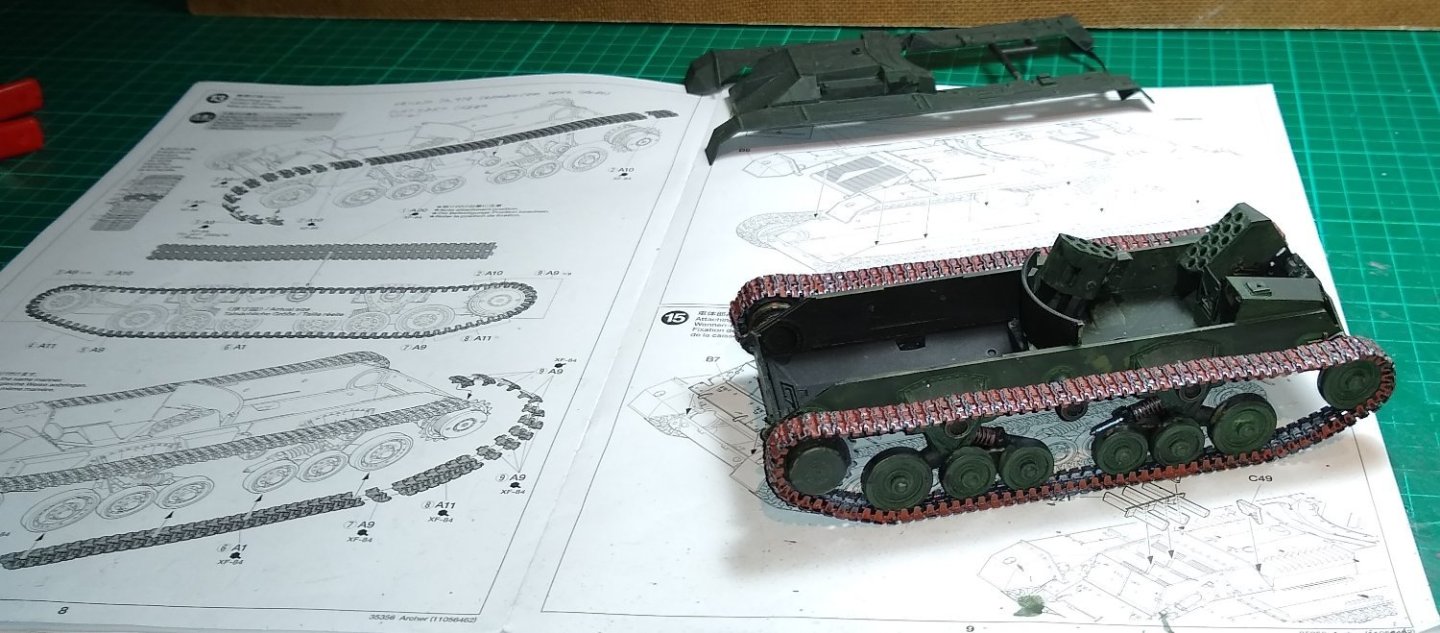
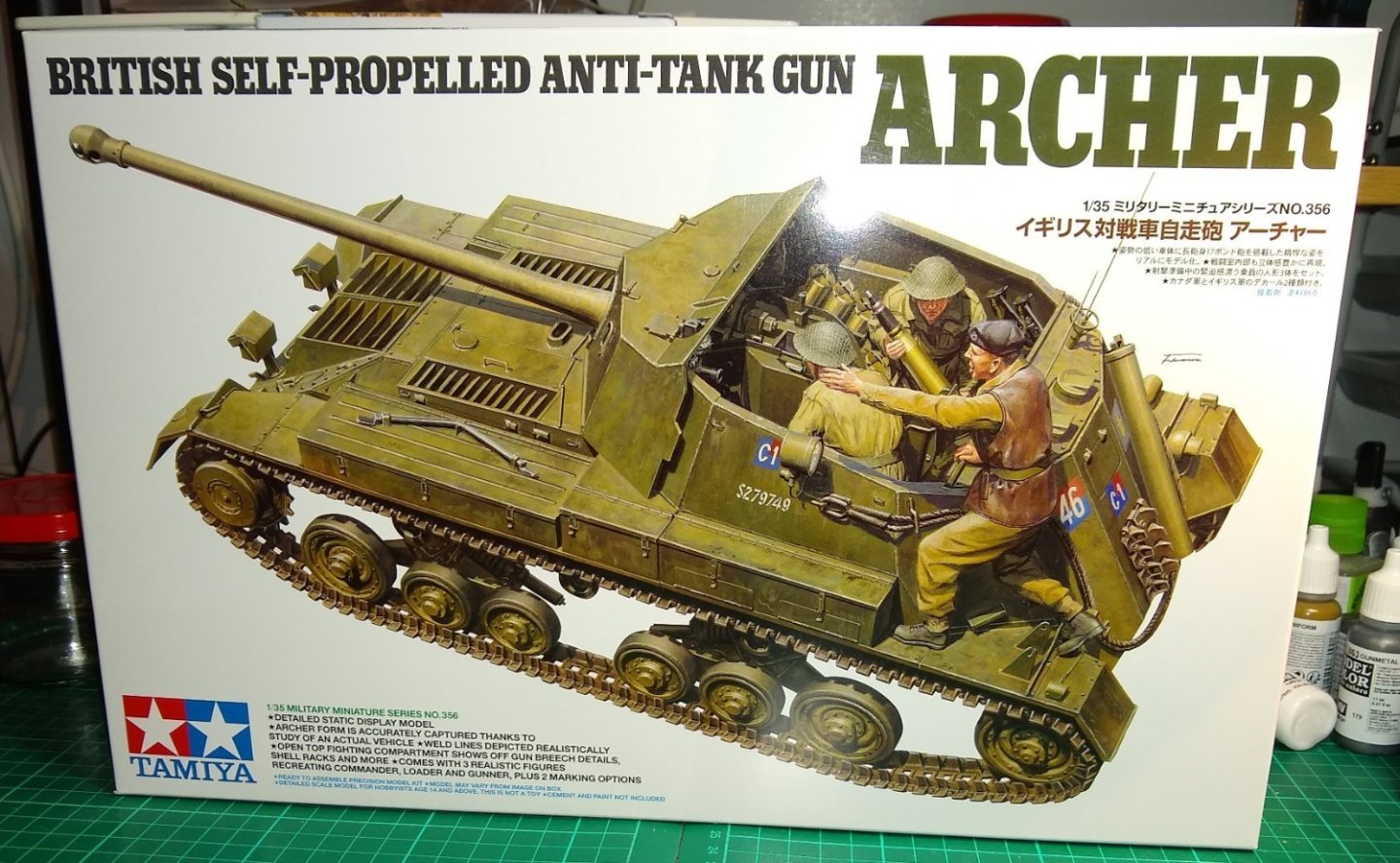

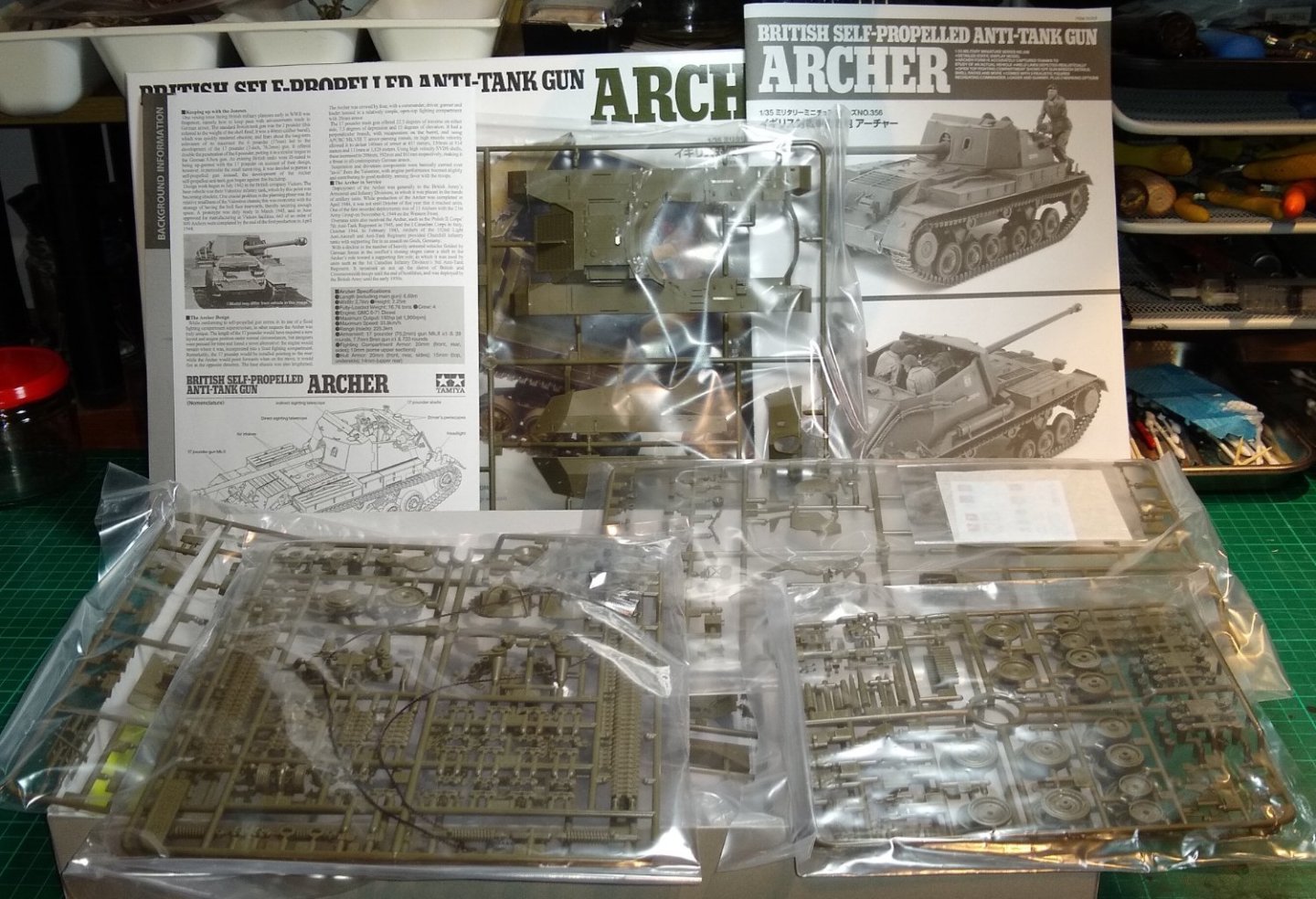
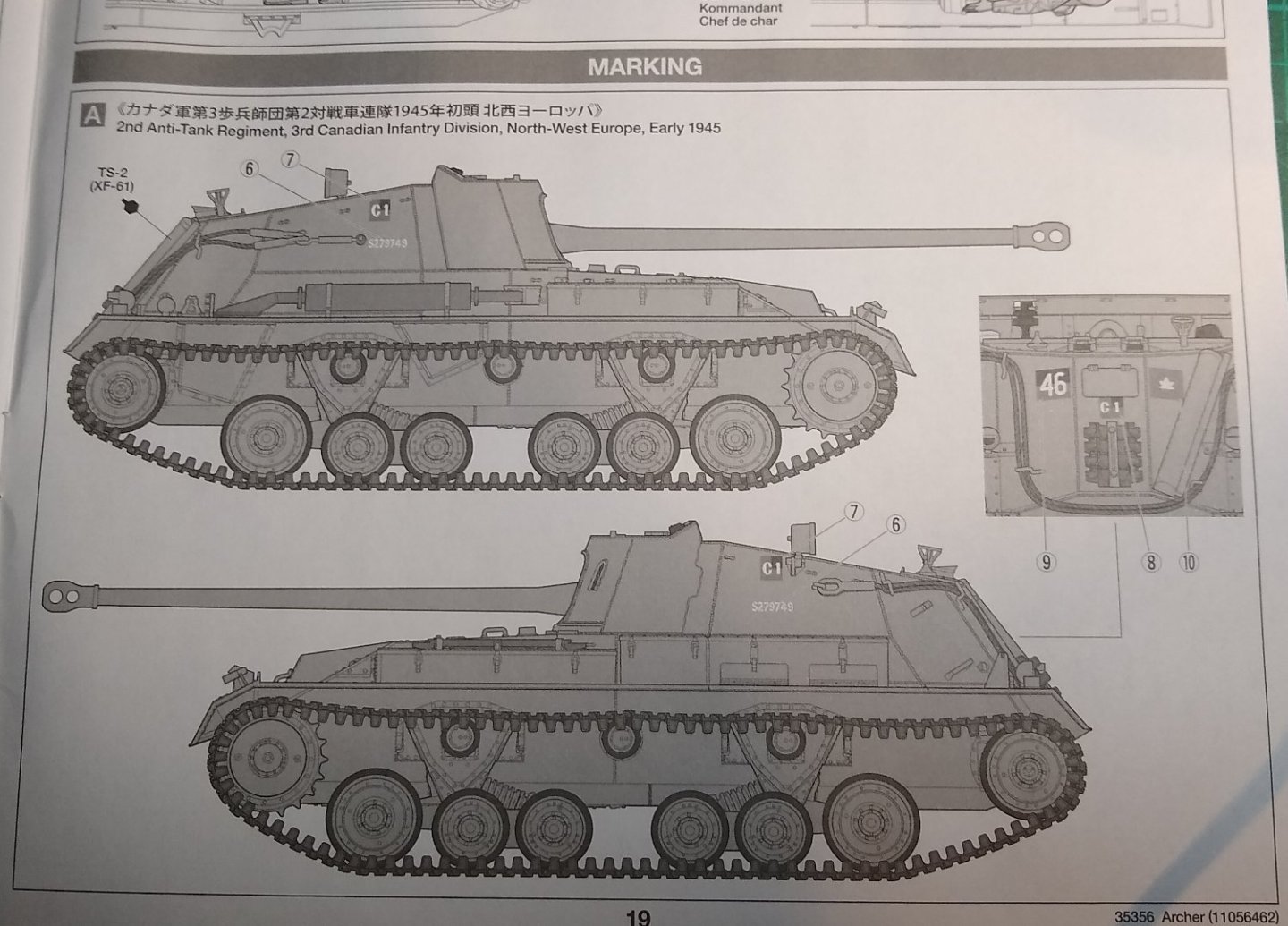
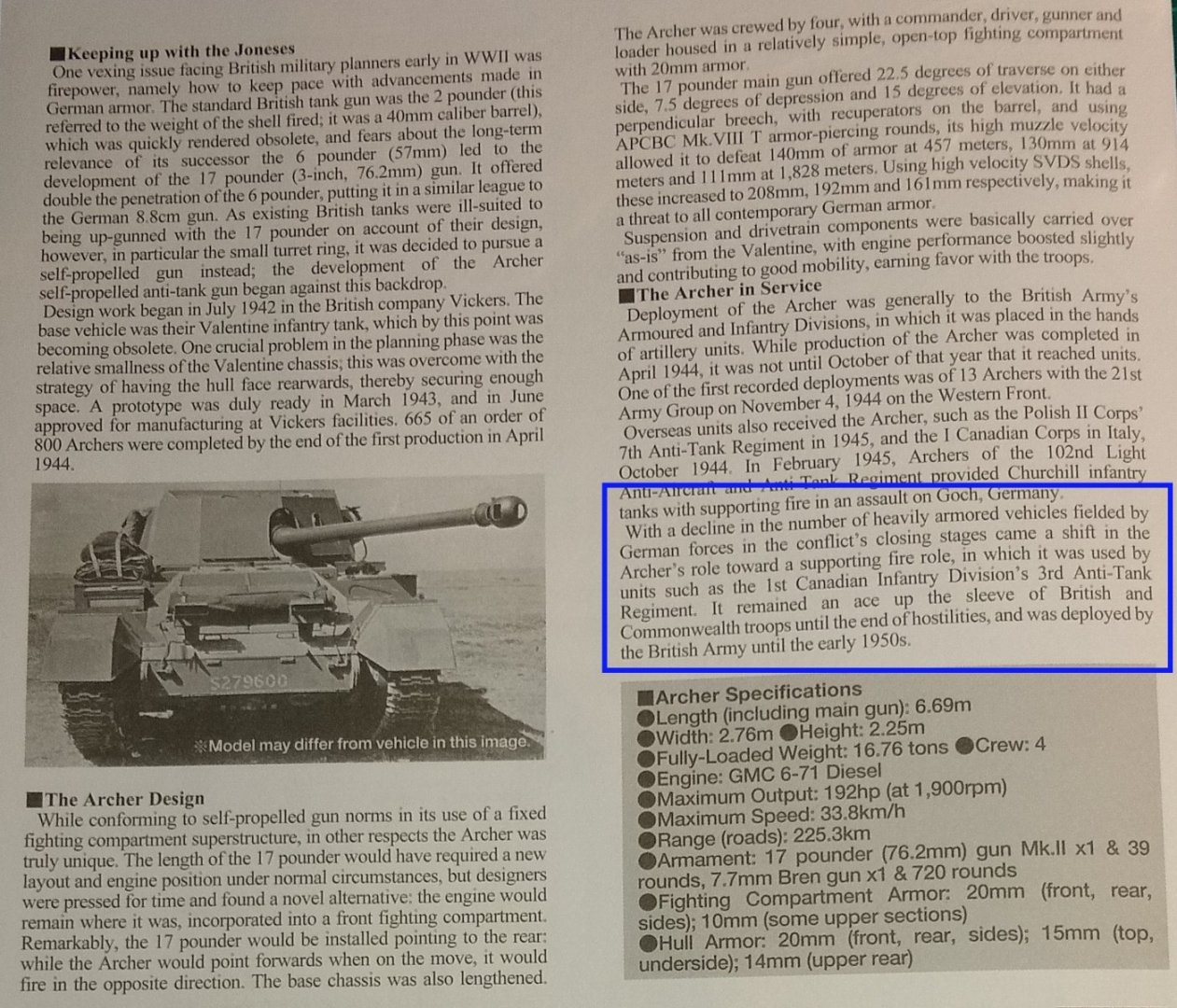
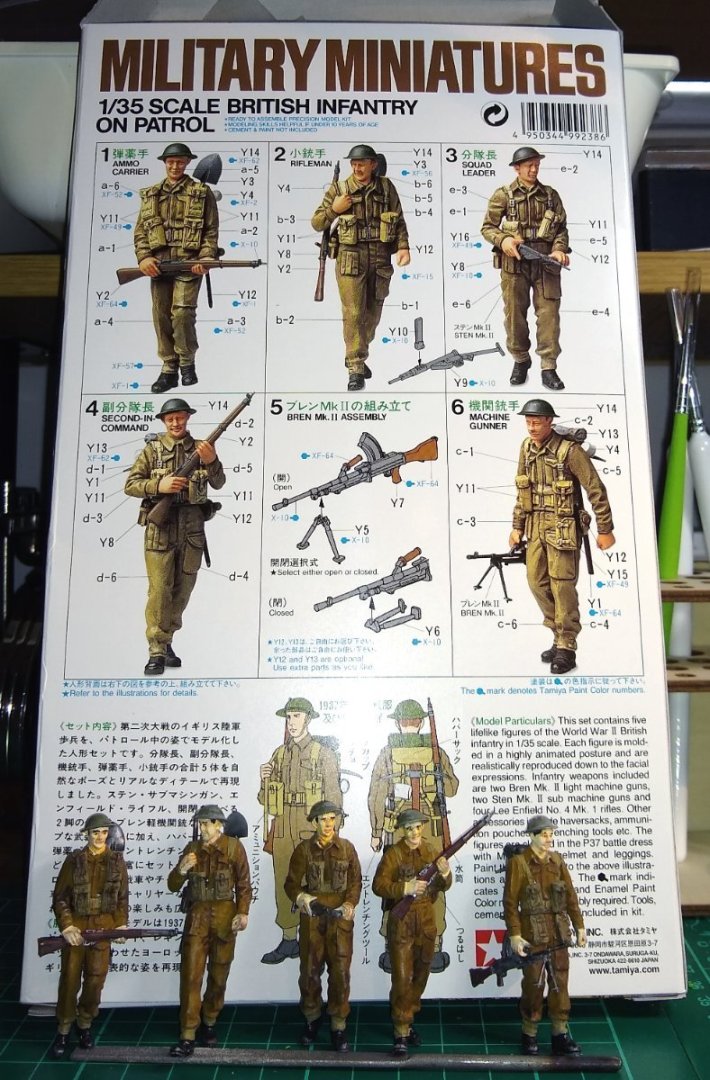
Archer self-propelled anti-tank gun by Rik Thistle - FINISHED - Tamiya 1:35 - 1945
in Non-ship/categorised builds
Posted · Edited by Rik Thistle
Hi all,
Thank you all for the Likes and advice.
Now, an update on my 'fencing' construction etc.
Below, fence posts, hinge/latch posts and the field gate.
Above - I bought some matchstick blanks to use as fence posts, and gave them a grey undercoat. During the WWII era I suspect many fence posts were made using tree branches, but I think some probably used sawn timber. On the left are wooden strips wood-glued together to form the end supports for the gate. And finally the gate, based on images from the period.
Below - Fixing the fencing wire to the posts caused a bit of head scratching....normally staples would be used but at 1/32" (0.75mm) across I couldn't see how I could make them that small yet strong enough to press in to the wood. So 0.35 mm wire (...same as the fencing wire) was used to form a 'hook' that had the long leg glued in to a drilled hole in the post. That worked as well as I could hoped.
Laying out the posts on the raised banks to check I had the right number to look right. I also added braces to the two support posts. The posts were slightly tapered to give the impression of being made from actual tree trunks or large branches. The semi-circular groove on the right is caused by the sweep of the gate dragging on the ground. I also added some farm tractor tyre ruts. Finally I added two shades of AK grass. I don't have a Static Grass Applicator, but grass in farm fields, that hold livestock, tends to be flattened and bumpy anyway.
Trying to catch a 'staple' in focus....the paint bottle was positioned to assist the camera find focus.
Gate mounted in position. I suppose I could have made miniature metal hinges for the gate, but made do with tiny blocks of wood to simulate the hinges.
Another view of the gate.
And finally, Marguerite still patiently waits for the hay to be thrown over.
Next is probably painting the Archer crew, finding the makings of a suitable tree for the left side of the scenario, and adding the hedge rows, There's also dirt to be added on the road, small rocks in the ditches and more weathering of the vehicle and landscape.
That's it for this week, all the best,
Richard